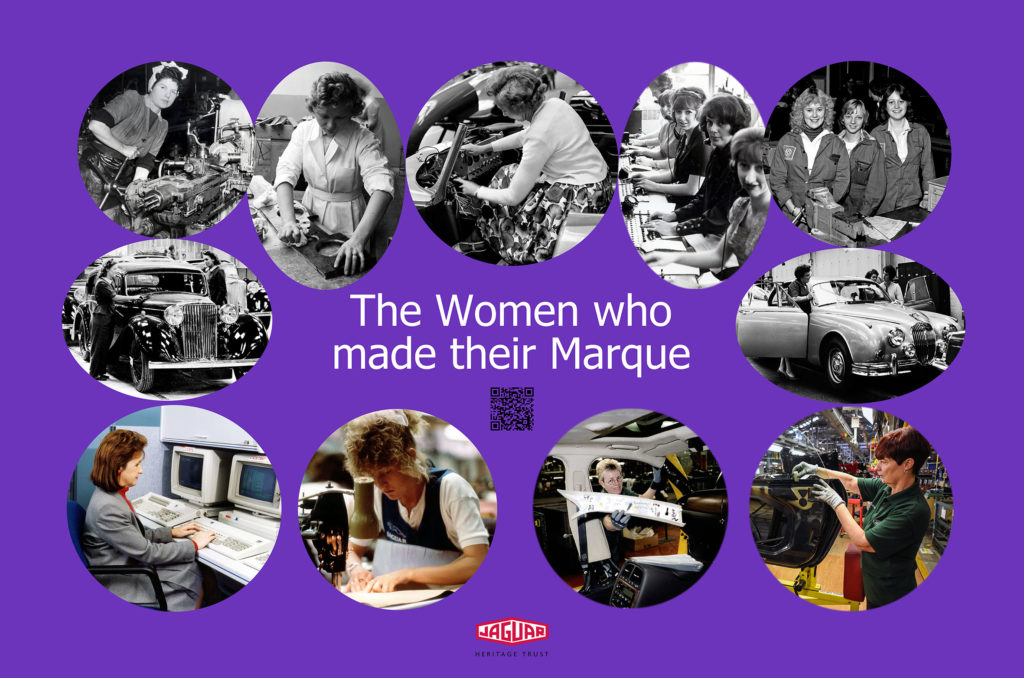
The Women Who Made Their Marque Exhibition
Welcome to “The Women Who Made Their Marque” exhibition and thank you to everyone who has contributed material.
This exhibition was launched on Friday 8 March 2024 on International Women’s Day. It celebrates the women who over the years have made, sold, raced, and contributed to ‘Jaguar’ and its associated marques in myriad ways.
We hope those featured will inspire other women to consider a career in the Automotive Industry in which they currently represent only 20% of the UK workforce.
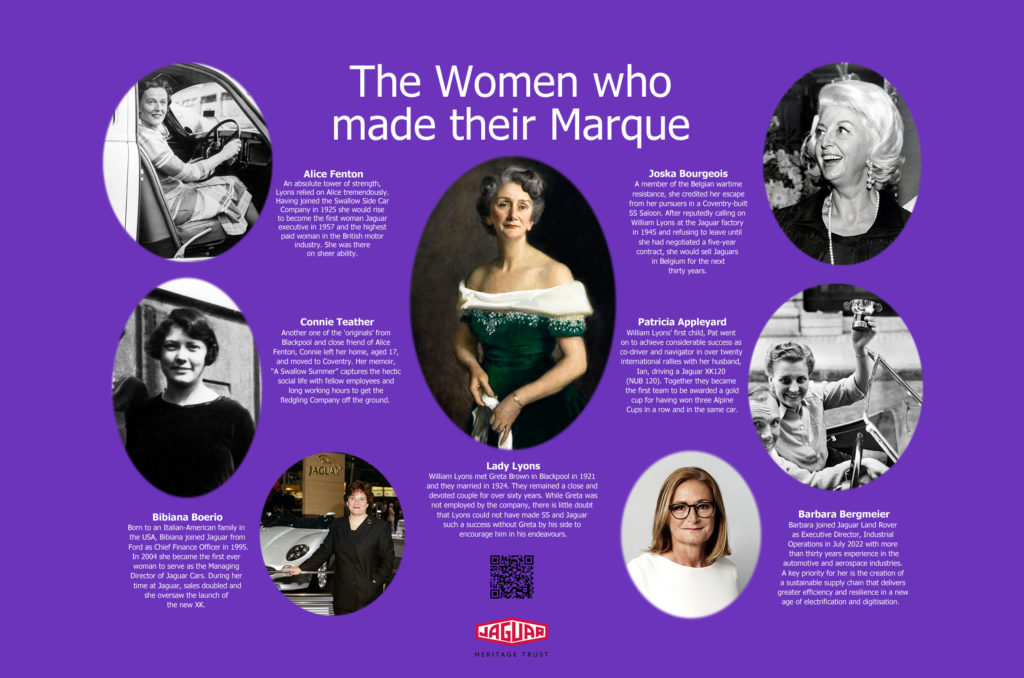
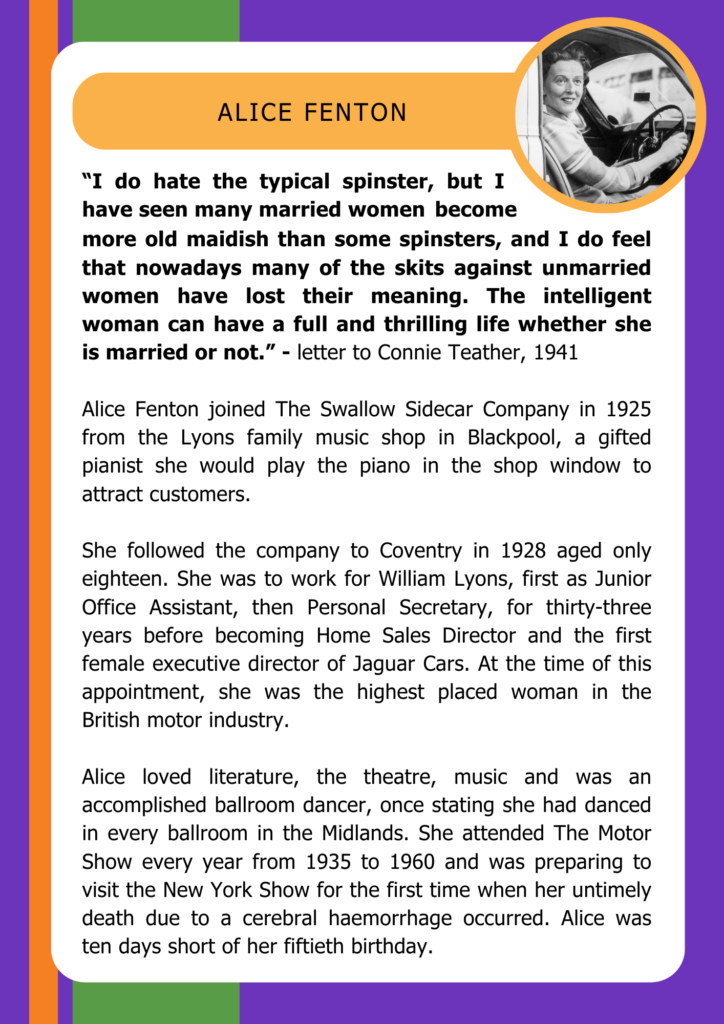
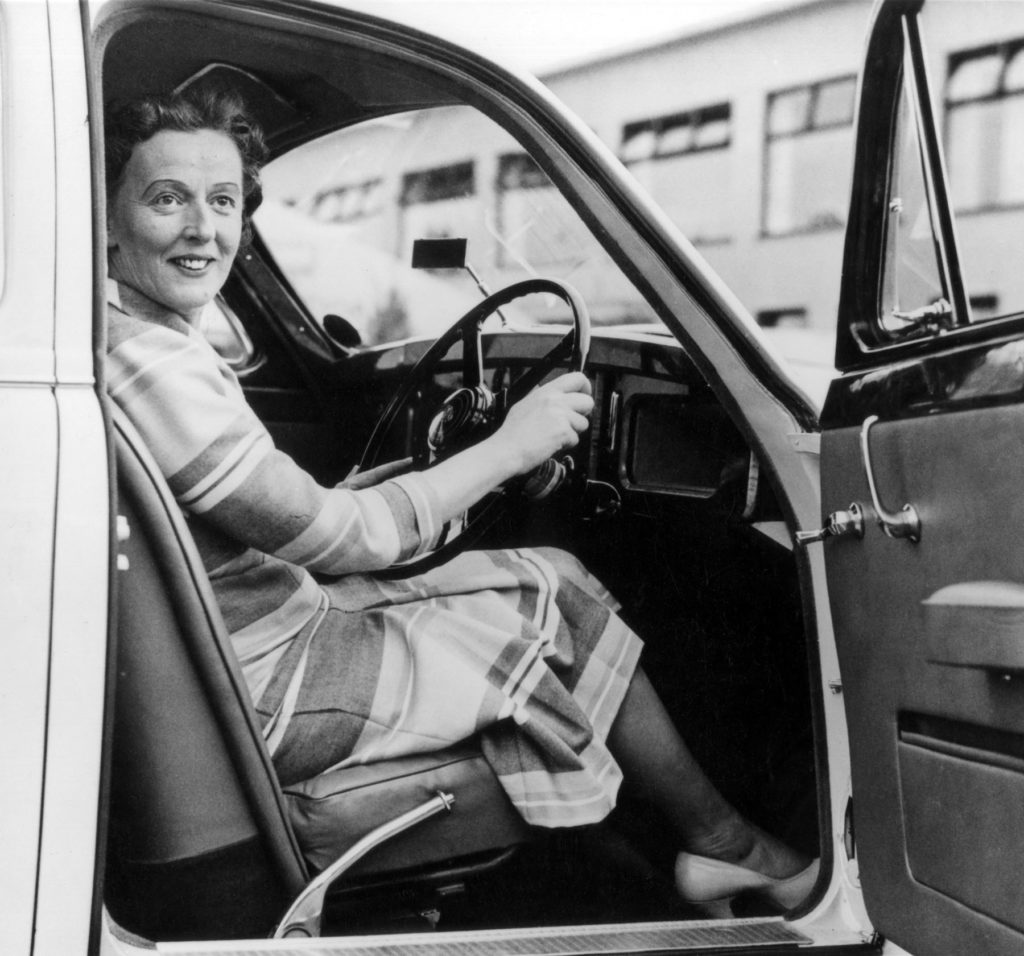
Alice Fenton
“I do hate the typical spinster, but I have seen many married women become more old maidish than some spinsters, and I do feel that nowadays many of the skits against unmarried women have lost their meaning. The intelligent woman can have a full and thrilling life whether she is married or not.” – letter to Connie Teather, 1941
Alice Fenton joined The Swallow Sidecar Company in 1925 from the Lyons family music shop in Blackpool, a gifted pianist she would play the piano in the shop window to attract customers.
She followed the company to Coventry in 1928 aged only eighteen. She was to work for William Lyons, first as Junior Office Assistant, then Personal Secretary, for thirty-three years before becoming Home Sales Director and the first female executive director of Jaguar Cars. At the time of this appointment, she was the highest placed woman in the British motor industry.
Alice loved literature, the theatre, music and was an accomplished ballroom dancer, once stating she had danced in every ballroom in the Midlands. She attended The Motor Show every year from 1935 to 1960 and was preparing to visit the New York Show for the first time when her untimely death due to a cerebral haemorrhage occurred. Alice was ten days short of her fiftieth birthday.
Click the button to read more information on Alice Fenton:
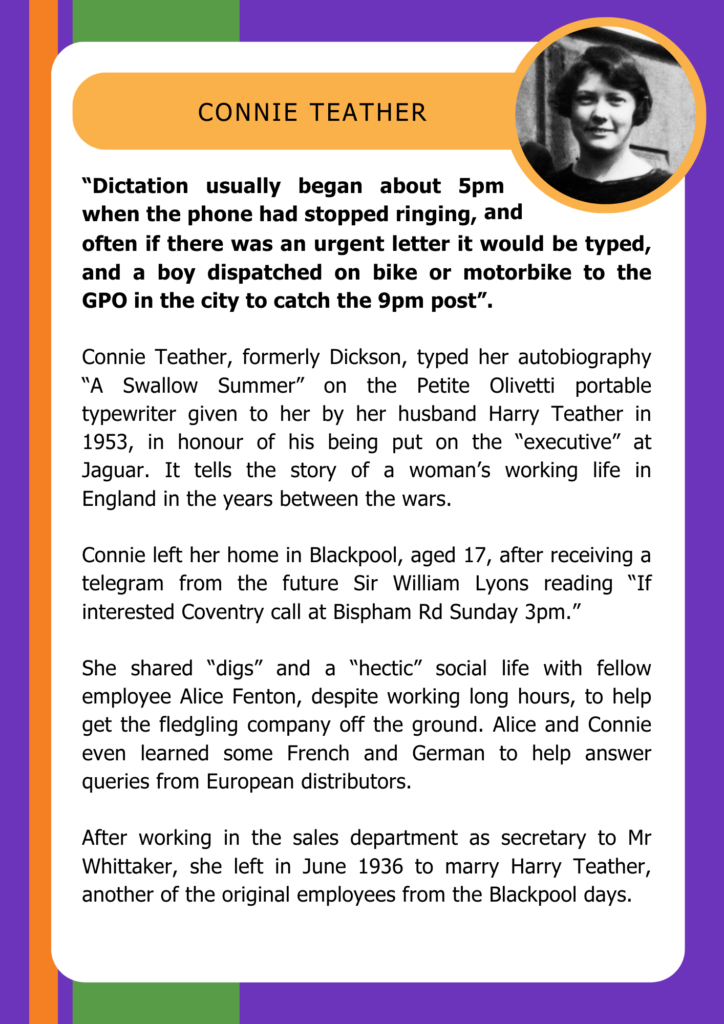
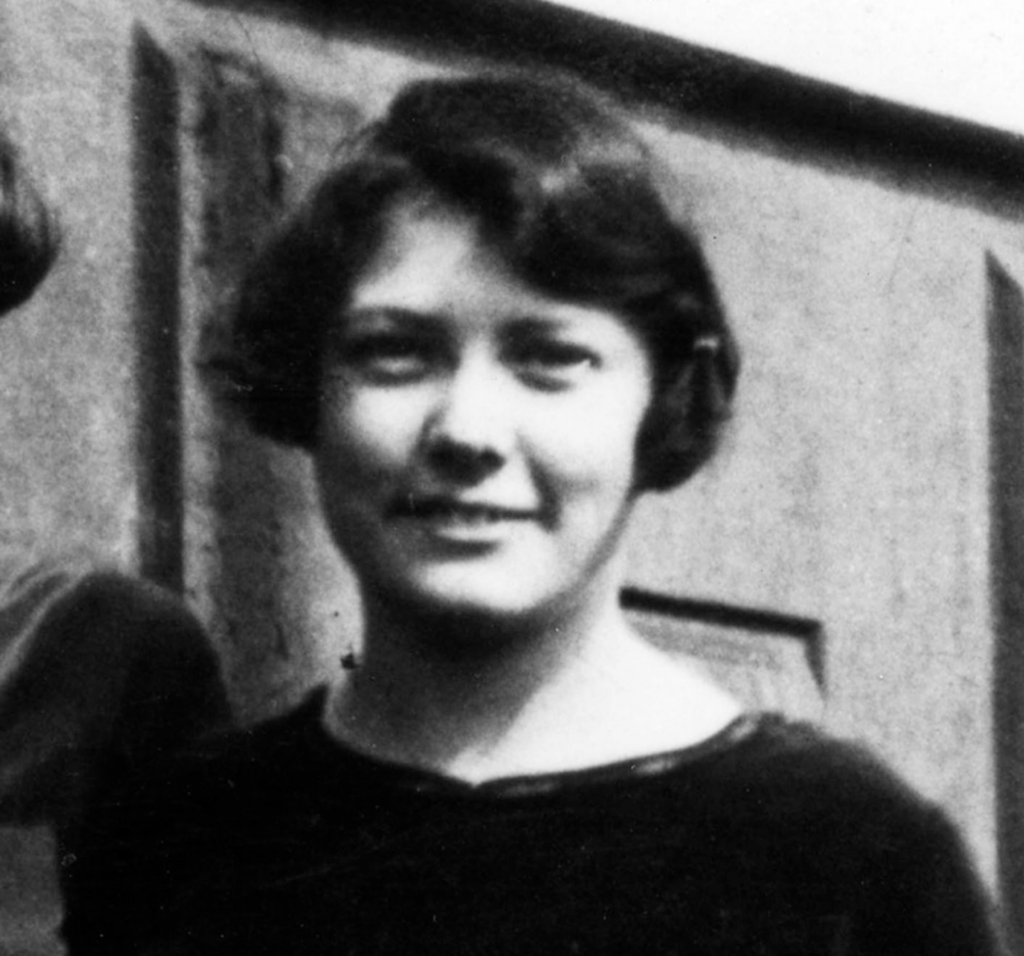
Connie Teather
“Dictation usually began about 5pm when the phone had stopped ringing, and often if there was an urgent letter it would be typed, and a boy dispatched on bike or motorbike to the GPO in the city to catch the 9pm post”.
Connie Teather, formerly Dickson, typed her autobiography “A Swallow Summer” on the Petite Olivetti portable typewriter given to her by her husband Harry Teather in 1953, in honour of his being put on the “executive” at Jaguar. It tells the story of a woman’s working life in England in the years between the wars.
Connie left her home in Blackpool, aged 17, after receiving a telegram from the future Sir William Lyons reading “If interested Coventry call at Bispham Rd Sunday 3pm.”
She shared “digs” and a “hectic” social life with fellow employee Alice Fenton, despite working long hours, to help get the fledgling company off the ground. Alice and Connie even learned some French and German to help answer queries from European distributors.
After working in the sales department as secretary to Mr Whittaker, she left in June 1936 to marry Harry Teather, another of the original employees from the Blackpool days.
Click the button to read more information on Connie Teather:
Click the button to read Connie Teathers’ Memoir of the early days of the company, “A Swallow Summer”:
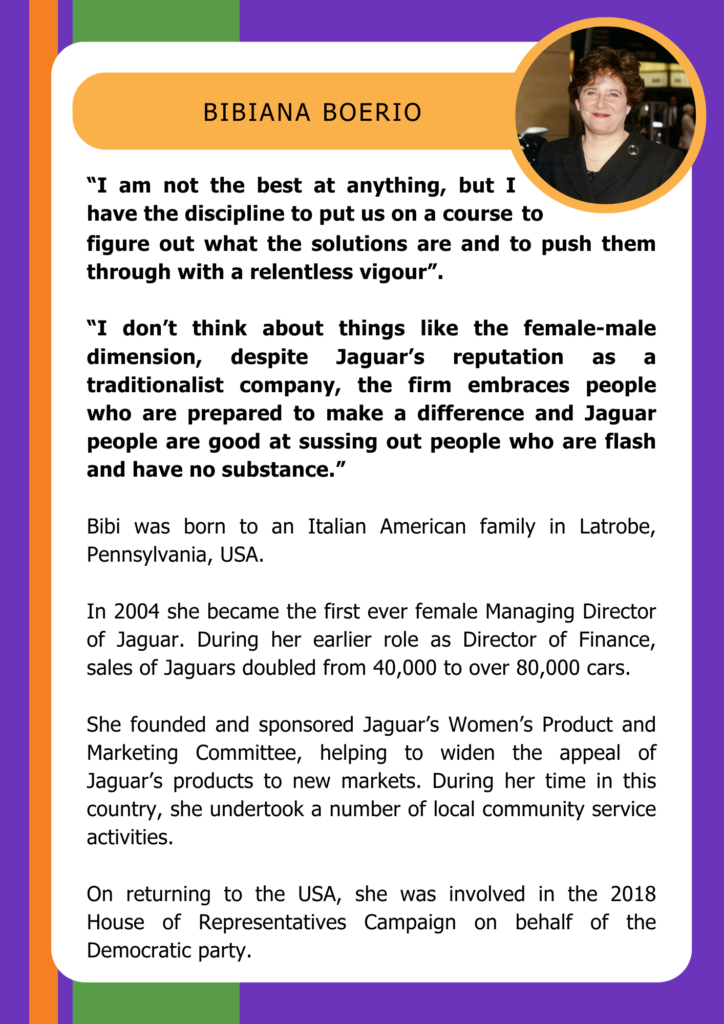
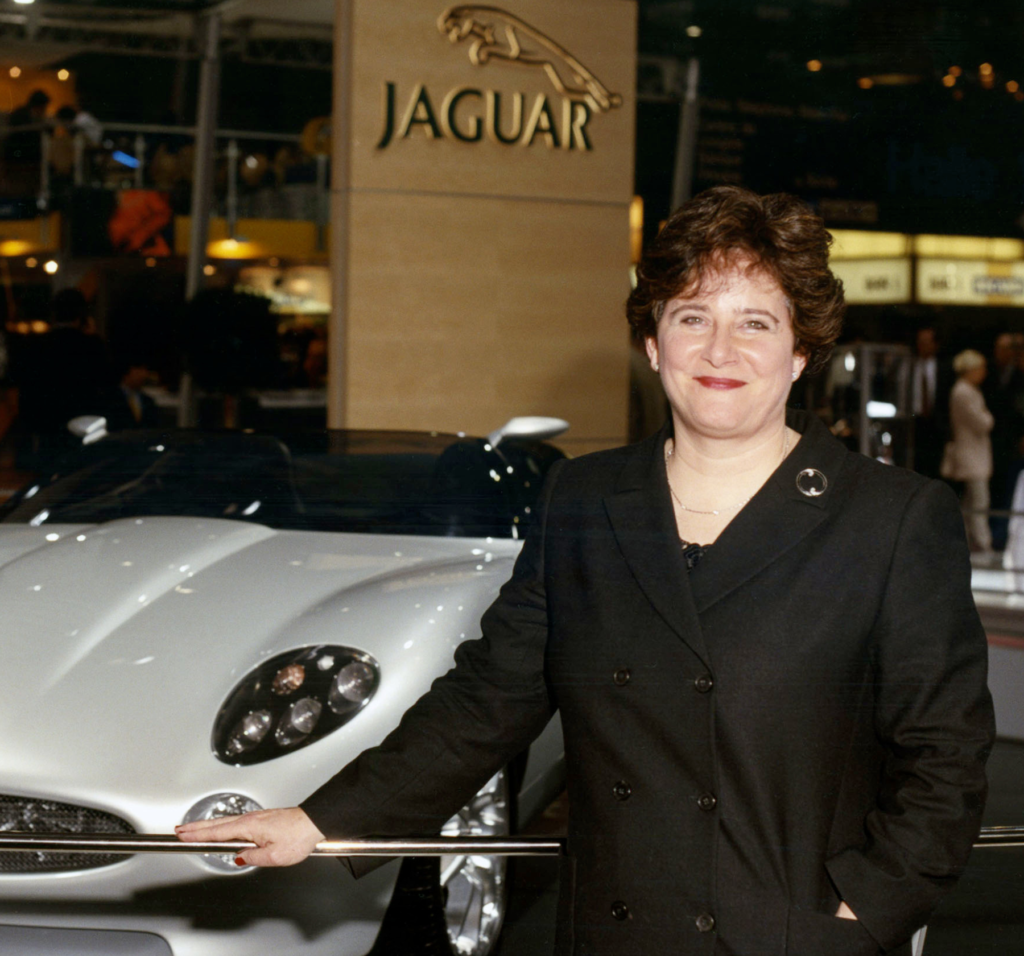
Bibiana Boerio
“I am not the best at anything, but I have the discipline to put us on a course to figure out what the solutions are and to push them through with a relentless vigour”.
“I don’t think about things like the female-male dimension, despite Jaguar’s reputation as a traditionalist company, the firm embraces people who are prepared to make a difference and Jaguar people are good at sussing out people who are flash and have no substance.”
Bibi was born to an Italian American family in Latrobe, Pennsylvania, USA.
In 2004 she became the first ever female Managing Director of Jaguar. During her earlier role as Director of Finance, sales of Jaguars doubled from 40,000 to over 80,000 cars.
She founded and sponsored Jaguar’s Women’s Product and Marketing Committee, helping to widen the appeal of Jaguar’s products to new markets. During her time in this country, she undertook a number of local community service activities.
On returning to the USA, she was involved in the 2018 House of Representatives Campaign on behalf of the Democratic party.
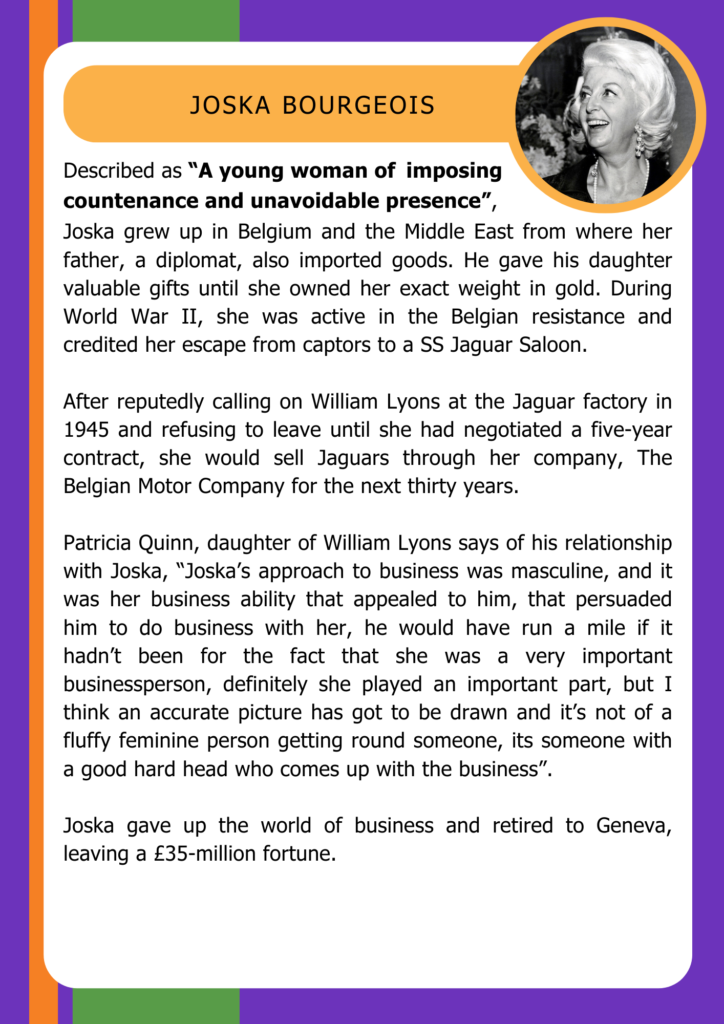
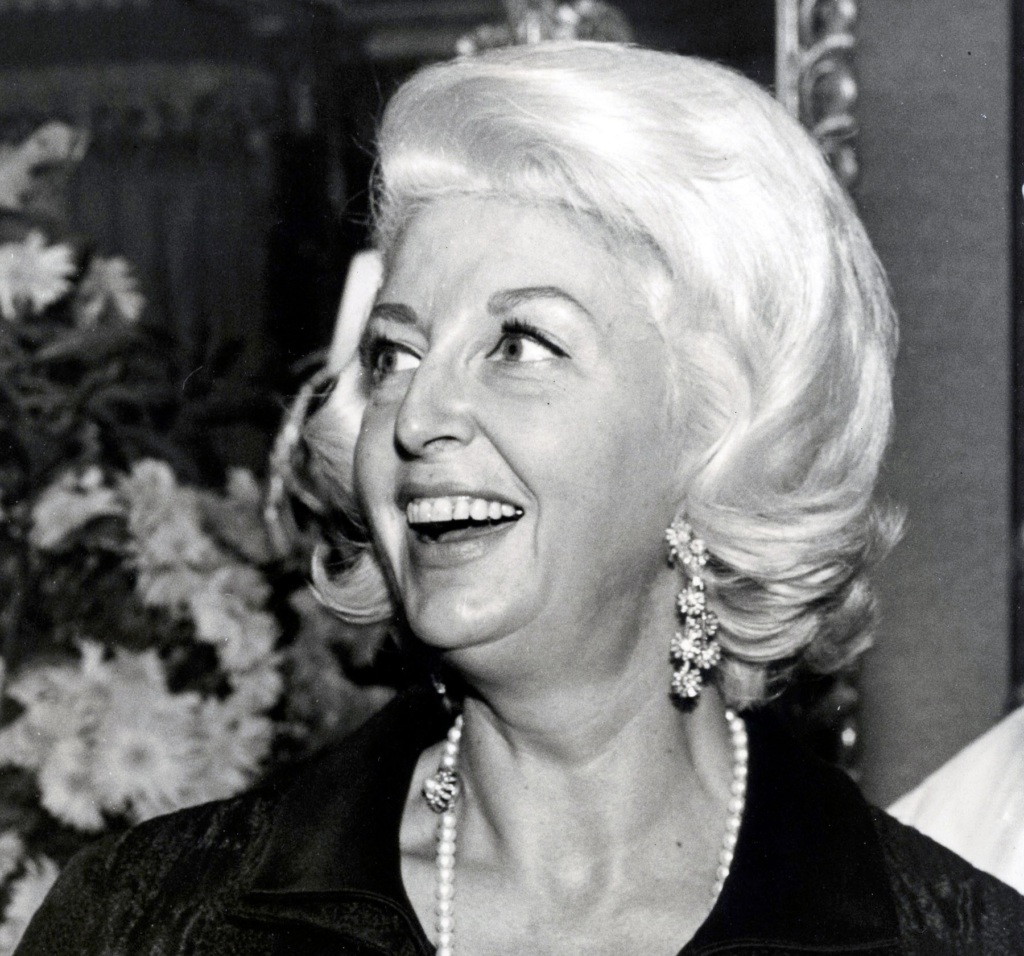
Joska Bourgeois
Described as “A young woman of imposing countenance and unavoidable presence”, Joska grew up in Belgium and the Middle East from where her father, a diplomat, also imported goods. He gave his daughter valuable gifts until she owned her exact weight in gold. During World War II, she was active in the Belgian resistance and credited her escape from captors to a SS Jaguar Saloon.
After reputedly calling on William Lyons at the Jaguar factory in 1945 and refusing to leave until she had negotiated a five-year contract, she would sell Jaguars through her company, The Belgian Motor Company for the next thirty years.
Patricia Quinn, daughter of William Lyons says of his relationship with Joska, “Joska’s approach to business was masculine, and it was her business ability that appealed to him, that persuaded him to do business with her, he would have run a mile if it hadn’t been for the fact that she was a very important businessperson, definitely she played an important part, but I think an accurate picture has got to be drawn and it’s not of a fluffy feminine person getting round someone, its someone with a good hard head who comes up with the business”.
Joska gave up the world of business and retired to Geneva, leaving a £35-million fortune.
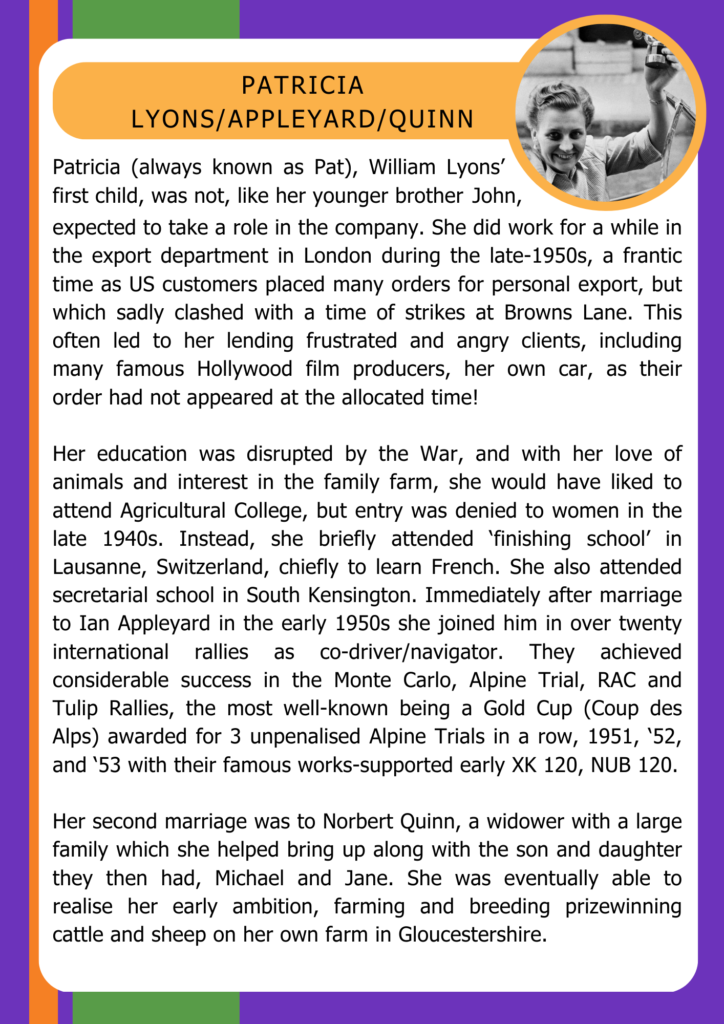
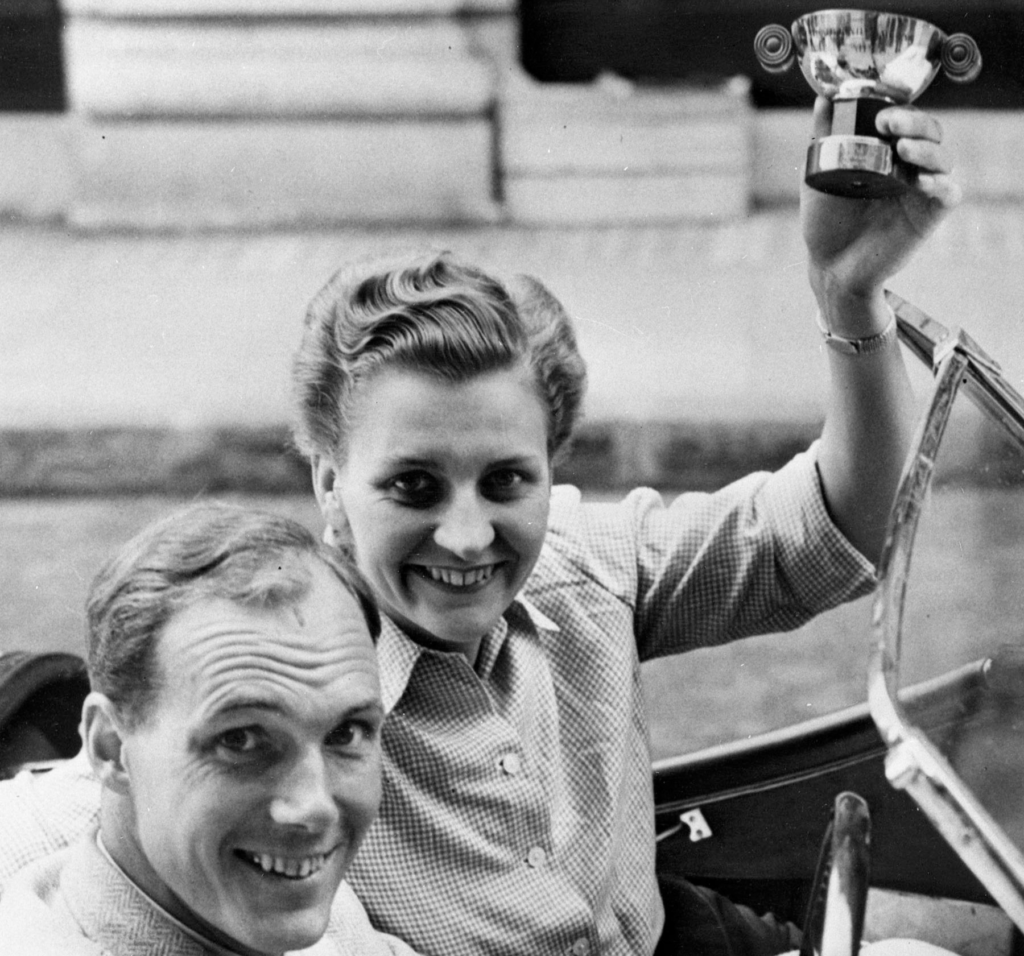
Patricia Lyons/Appleyard/Quinn
Patricia (always known as Pat), William Lyons’ first child, was not, like her younger brother John, expected to take a role in the company. She did work for a while in the export department in London during the late-1950s, a frantic time as US customers placed many orders for personal export, but which sadly clashed with a time of strikes at Browns Lane. This often led to her lending frustrated and angry clients, including many famous Hollywood film producers, her own car, as their order had not appeared at the allocated time!
Her education was disrupted by the War, and with her love of animals and interest in the family farm, she would have liked to attend Agricultural College, but entry was denied to women in the late 1940s. Instead, she briefly attended ‘finishing school’ in Lausanne, Switzerland, chiefly to learn French. She also attended secretarial school in South Kensington. Immediately after marriage to Ian Appleyard in the early 1950s she joined him in over twenty international rallies as co-driver/navigator. They achieved considerable success in the Monte Carlo, Alpine Trial, RAC and Tulip Rallies, the most well-known being a Gold Cup (Coup des Alps) awarded for 3 unpenalised Alpine Trials in a row, 1951, ‘52, and ‘53 with their famous works-supported early XK 120, NUB 120.
Her second marriage was to Norbert Quinn, a widower with a large family which she helped bring up along with the son and daughter they then had, Michael and Jane. She was eventually able to realise her early ambition, farming and breeding prizewinning cattle and sheep on her own farm in Gloucestershire.
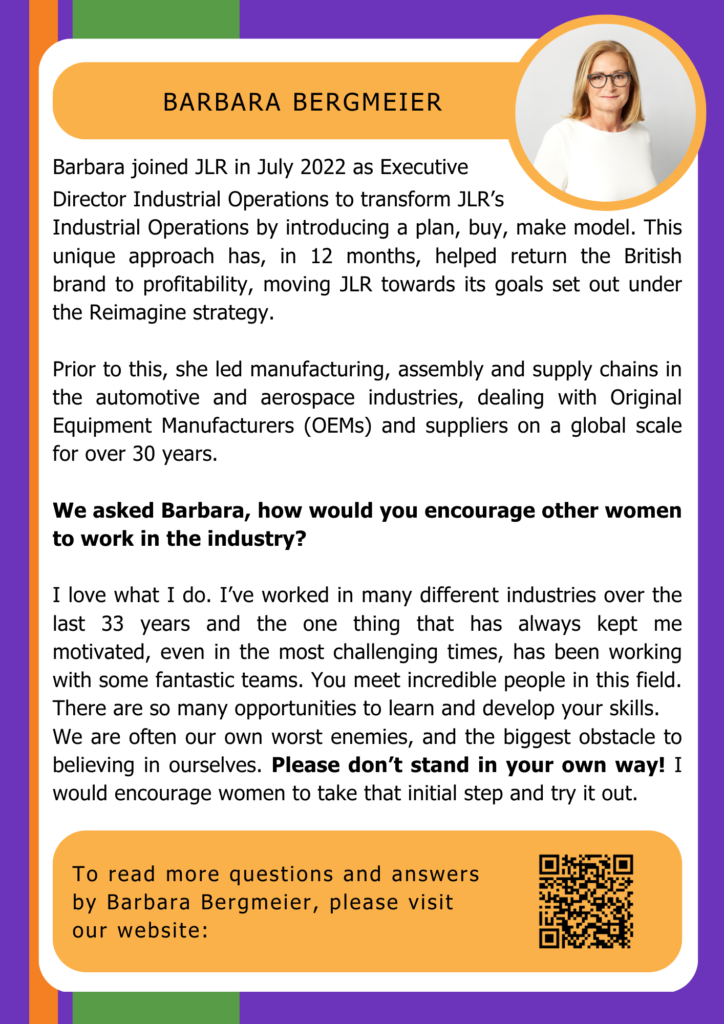
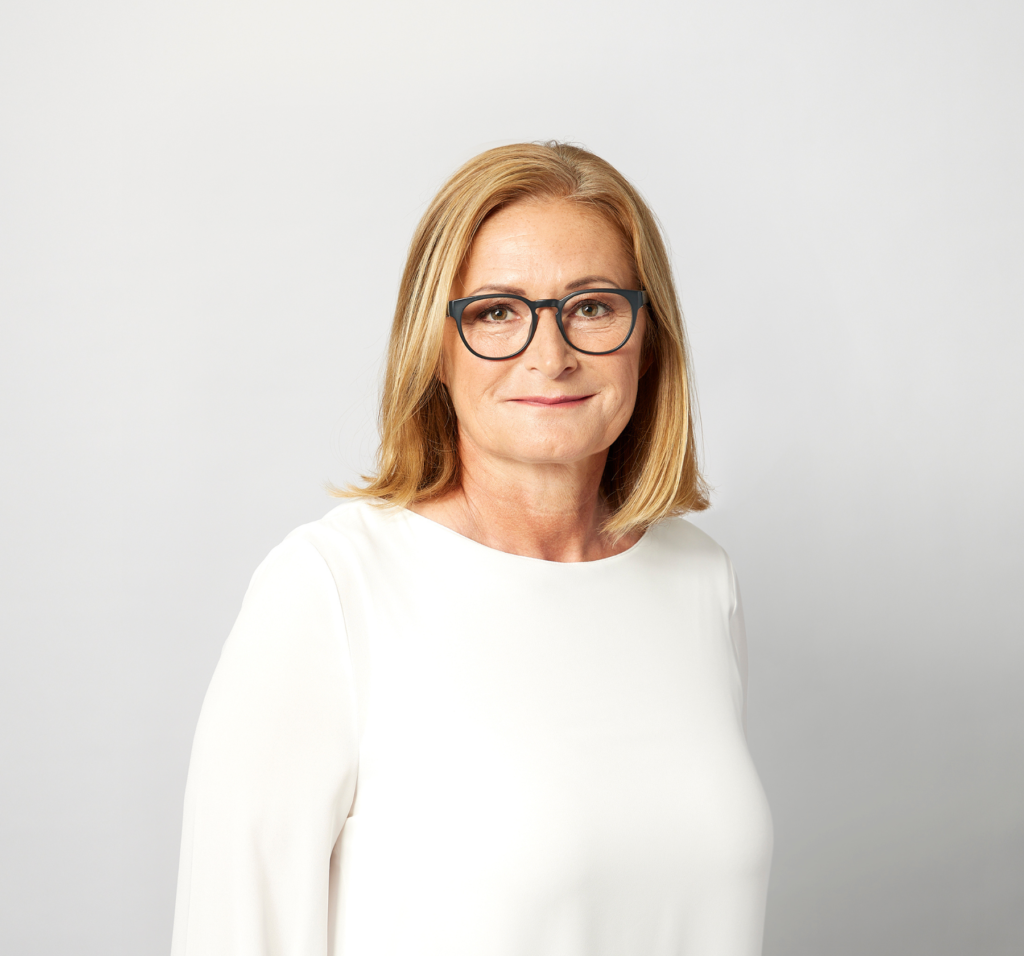
Barbara Bergmeier
Can you briefly introduce yourself and your role?
Barbara Bergmeier, Executive Director Industrial Operations.
I joined JLR in July 2022 to transform JLR’s Industrial Operations by introducing a plan, buy, make model. This unique approach has, in 12 months, helped return the British brand to profitability, moving JLR towards its goals set out under the Reimagine strategy.
Prior to this, I’ve led manufacturing, assembly and supply chains in the automotive and aerospace industries, dealing with Original Equipment Manufacturers (OEMs) and suppliers on a global scale for over 30 years.
Why did you choose to work in this industry and what does the Jaguar brand mean to you?
I love being in the manufacturing and engineering environment. At JLR, it’s so exciting being part of the end-to-end process creating our beautiful products. There’s nothing better than being at the manufacturing sites with our brilliant colleagues, seeing the cars being brought to life.
It can be challenging but you get to meet amazing people and build fantastic diverse teams along the way. It’s always a privilege when colleagues become friends and we stay connected.
The Jaguar brand is special, Jaguar is a blend of responsive performance that gets your pulse racing, dramatic design that makes you stop and stare and a sense of theatre that stirs your emotions. It’s so unique and we’re witnessing a once in a lifetime part of its story as it transforms into a pure-electric brand from 2025. It’s a truly aspirational brand – a copy of nothing.
The Society of Motor Manufacturers and Traders (SMMT) reported in December 2023 that women make up 48% of the workforce and only 20% in our industry, why do you think this is?
The world of engineering has changed so much since I started my career, but I believe encouraging more balanced gender diversity will help us break down the pervasive stereotypes that still exist.
The idea of engineering as a male dominated industry still creates stereotypes and can make the industry feel daunting. We should tackle these myths and clearly show the broad range of sectors and career options that engineering covers.
Deloitte’s 2020 “Women in the Automotive Industry” research found that 40% of women would have chosen a different industry and 90% of women feel they are underrepresented in leadership positions while 42% believe an industry bias towards men for these positions still exists driven by organizational and cultural norms, do you agree and what form do you think these norms take? How can they be overcome?
Culture is so important. It’s strongest when we work together, for each other. We need to build this culture of inclusion across the industry through supportive networks, allies and encouraging honest, two-way communication.
Allyship is incredibly valuable. No matter gender, race, culture, sexual orientation and social mobility, it’s about creating a shared network of support to empower and create meaningful change. Creating a culture where women feel they can thrive, should in turn attract and retain more women in the industry.
We should also encourage initiatives such as Reverse Mentoring programmes. I’ve been part of this at JLR and it pairs senior leaders with employees from across the business. It’s about having open conversations and it’s a real poignant reminder that leadership isn’t about titles or positions; it’s about the values we uphold and how we treat others. It’s about compassion, empathy, friendliness, and helpfulness – qualities that go beyond any hierarchy.
Plan International UK reported that 35% of young women feel they would not be taken seriously if they pursued a Science, Technology, Engineering, Mathematics, (STEM) based career, did you study STEM subjects and what do you think about this statement?
During my computer science classes at university, I was one of only two women! I still actively chose a career in a very male-dominated industry as I loved the type of work, and I knew I wanted to build a career around manufacturing and engineering.
There has been progress but there is still lot more we can do to encourage more diversity. We need to get people interested in Science, Technology, Engineering, Maths (STEM) topics at a much younger age and inspire them to want to continue studying them.
We need to offer training programmes where we can recognise transferable skills – identifying people who may not have the traditional qualifications and working to upskill them to new roles which they are perfectly suited for. In a first for JLR, candidates with BTEC and T-Level qualifications can now apply for its Higher Apprenticeship in engineering, alongside candidates with A-level maths.
There is so much talent in the world and we need to create opportunities to harness it. We need to inspire people with strong role models and show them the fantastic career opportunities that exist in manufacturing and engineering.
How would you encourage other women to work in the industry?
I love what I do. I’ve worked in many different industries over the last 33 years and the one thing that has always kept me motivated, even in the most challenging times, has been working with some fantastic teams. You meet incredible people in this field. There are so many opportunities to learn and develop your skills.
We are often our own worst enemies, and the biggest obstacle to believing in ourselves. Please don’t stand in your own way! I would encourage women to take that initial step and try it out.
What have been the highlights of your career experience?
A recent career highlight has been driving success in Industrial Operations through team empowerment, resulting in operational stability and confidence to deliver our plan.
The biggest reward for me is seeing the team turnaround their own operational performance, resulting in confidence through the supply chain, which is a fantastic achievement. What a team!
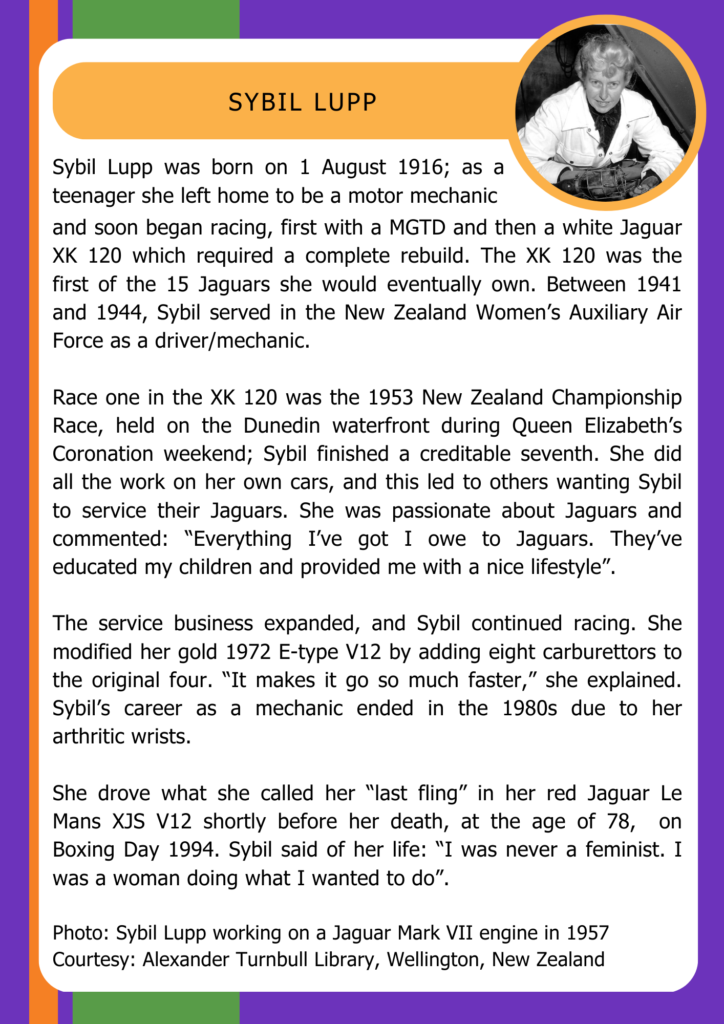
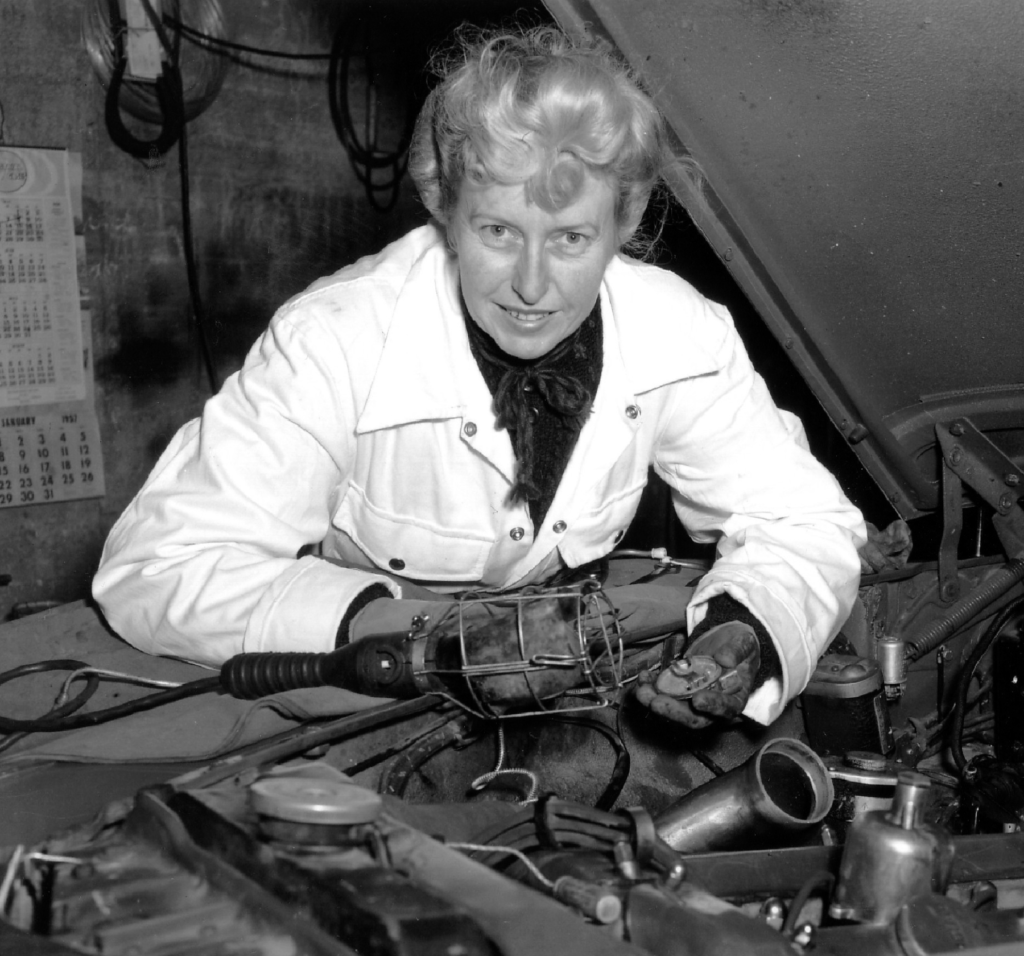
Sybil Lupp
Sybil Lupp was born on 1 August 1916; as a teenager she left home to be a motor mechanic and soon began racing, first with a MGTD and then a white Jaguar XK 120 which required a complete rebuild. The XK 120 was the first of the 15 Jaguars she would eventually own. Between 1941 and 1944, Sybil served in the New Zealand Women’s Auxiliary Air Force as a driver/mechanic.
Race one in the XK 120 was the 1953 New Zealand Championship Race, held on the Dunedin waterfront during Queen Elizabeth’s Coronation weekend; Sybil finished a creditable seventh. She did all the work on her own cars, and this led to others wanting Sybil to service their Jaguars. She was passionate about Jaguars and commented: “Everything I’ve got I owe to Jaguars. They’ve educated my children and provided me with a nice lifestyle”.
The service business expanded, and Sybil continued racing. She modified her gold 1972 E-type V12 by adding eight carburettors to the original four. “It makes it go so much faster, ” she explained. Sybil’s career as a mechanic ended in the 1980s due to her arthritic wrists.
She drove what she called her “last fling” in her red Jaguar Le Mans XJS V12 shortly before her death, at the age of 78, on Boxing Day 1994. Sybil said of her life: “I was never a feminist. I was a woman doing what I wanted to do”.
Photo: Sybil Lupp working on a Jaguar Mark VII engine in 1957
Courtesy: Alexander Turnbull Library, Wellington, New Zealand
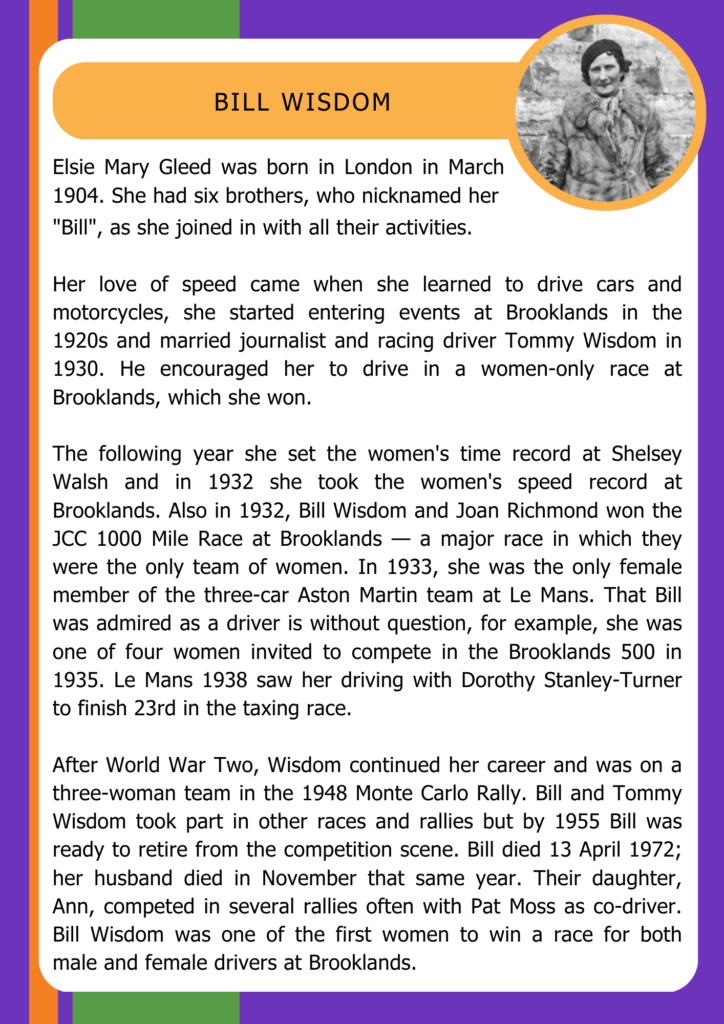
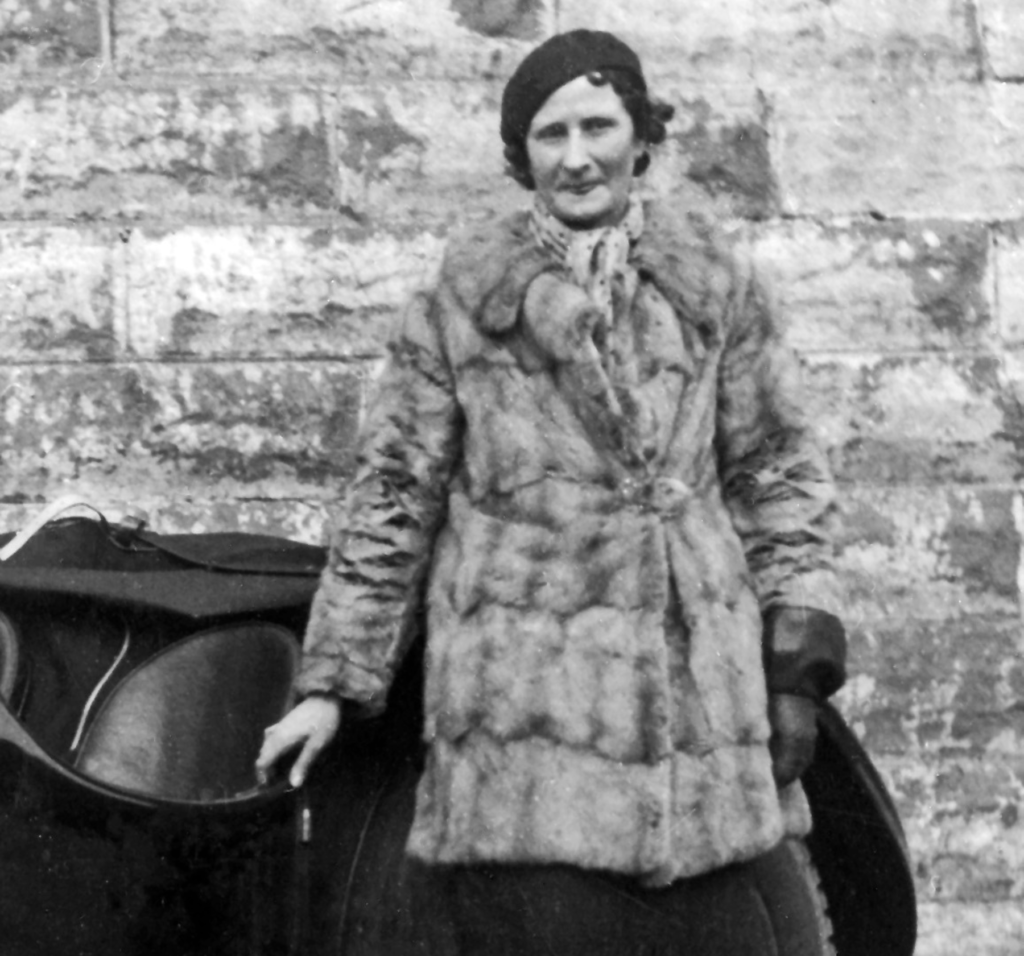
Bill Wisdom
Elsie Mary Gleed was born in London in March 1904. She had six brothers, who nicknamed her “Bill”, as she joined in with all their activities.
Her love of speed came when she learned to drive cars and motorcycles, she started entering events at Brooklands in the 1920s and married journalist and racing driver Tommy Wisdom in 1930. He encouraged her to drive in a women-only race at Brooklands, which she won.
The following year she set the women’s time record at Shelsey Walsh and in 1932 she took the women’s speed record at Brooklands. Also in 1932, Bill Wisdom and Joan Richmond won the JCC 1000 Mile Race at Brooklands — a major race in which they were the only team of women. In 1933, she was the only female member of the three-car Aston Martin team at Le Mans. That Bill was admired as a driver is without question, for example, she was one of four women invited to compete in the Brooklands 500 in 1935. Le Mans 1938 saw her driving with Dorothy Stanley-Turner to finish 23rd in the taxing race.
After World War Two, Wisdom continued her career and was on a three-woman team in the 1948 Monte Carlo Rally. Bill and Tommy Wisdom took part in other races and rallies but by 1955 Bill was ready to retire from the competition scene. Bill died 13 April 1972; her husband died in November that same year. Their daughter, Ann, competed in several rallies often with Pat Moss as co-driver. Bill Wisdom was one of the first women to win a race for both male and female drivers at Brooklands.
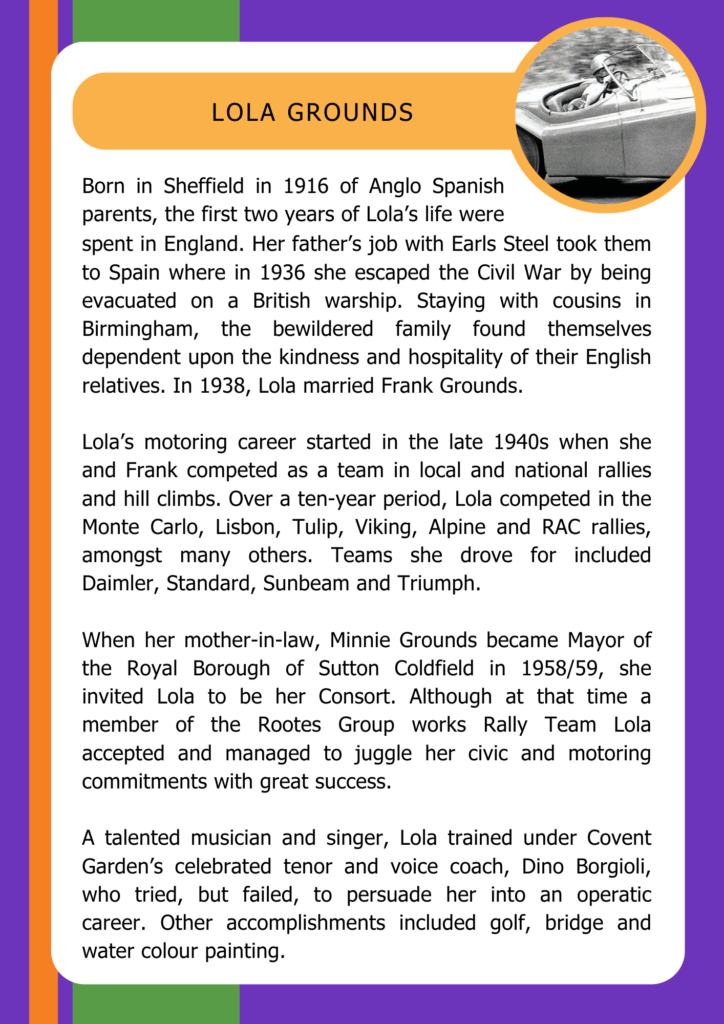
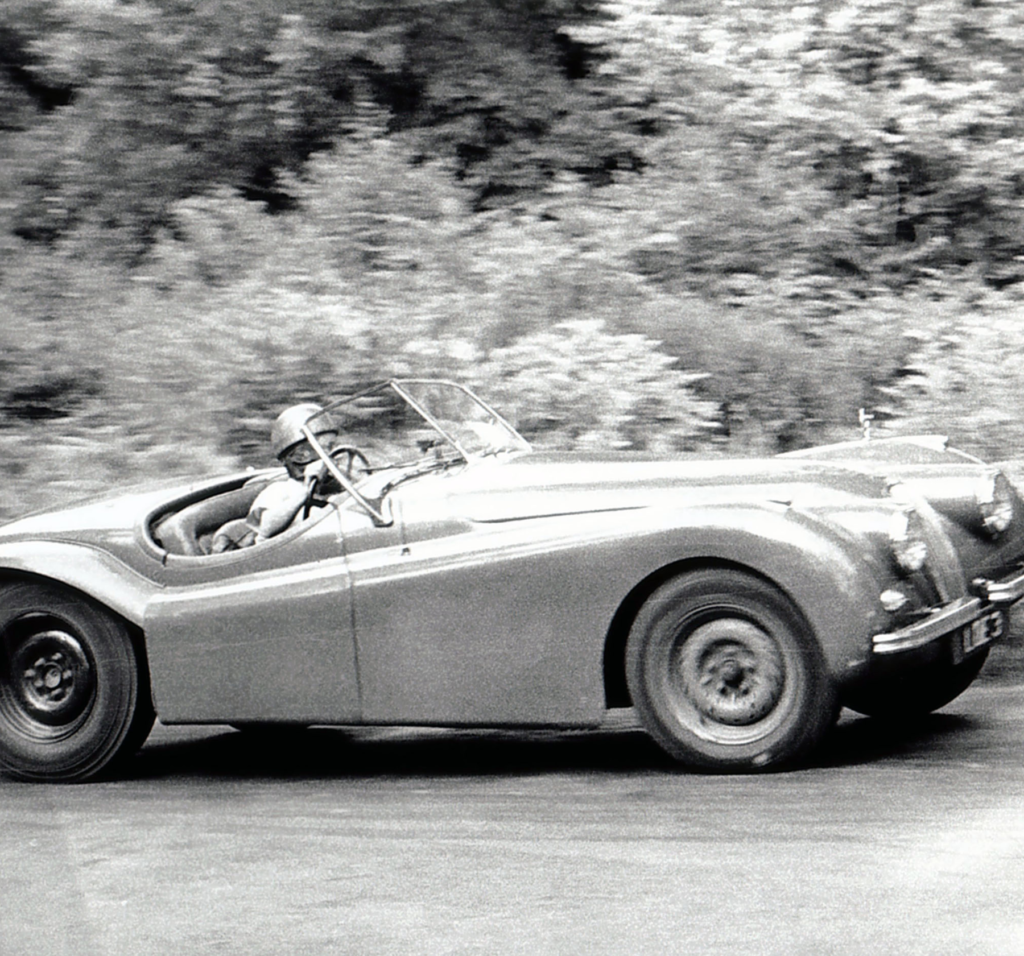
Lola Grounds
Born in Sheffield in 1916 of Anglo Spanish parents, the first two years of Lola’s life were spent in England. Her father’s job with Earls Steel took them to Spain where in 1936 she escaped the Civil War by being evacuated on a British warship. Staying with cousins in Birmingham, the bewildered family found themselves dependent upon the kindness and hospitality of their English relatives. In 1938, Lola married Frank Grounds.
Lola’s motoring career started in the late 1940s when she and Frank competed as a team in local and national rallies and hill climbs. Over a ten-year period, Lola competed in the Monte Carlo, Lisbon, Tulip, Viking, Alpine and RAC rallies, amongst many others. Teams she drove for included Daimler, Standard, Sunbeam and Triumph.
When her mother-in-law, Minnie Grounds became Mayor of the Royal Borough of Sutton Coldfield in 1958/59, she invited Lola to be her Consort. Although at that time a member of the Rootes Group works Rally Team Lola accepted and managed to juggle her civic and motoring commitments with great success.
A talented musician and singer, Lola trained under Covent Garden’s celebrated tenor and voice coach, Dino Borgioli, who tried, but failed, to persuade her into an operatic career. Other accomplishments included golf, bridge and water colour painting.
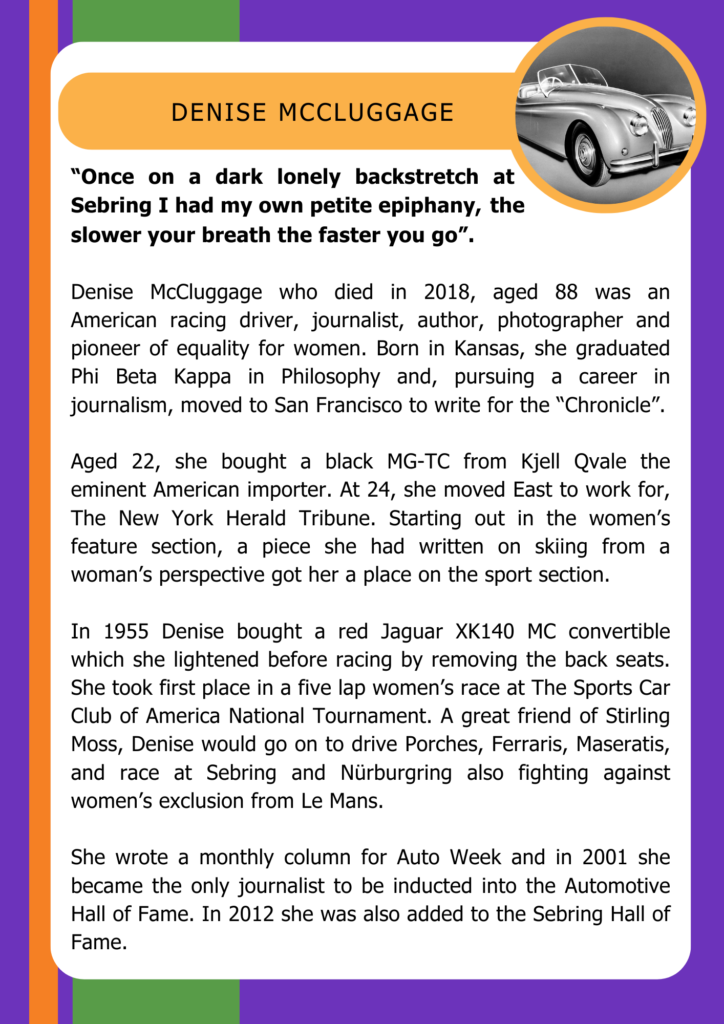
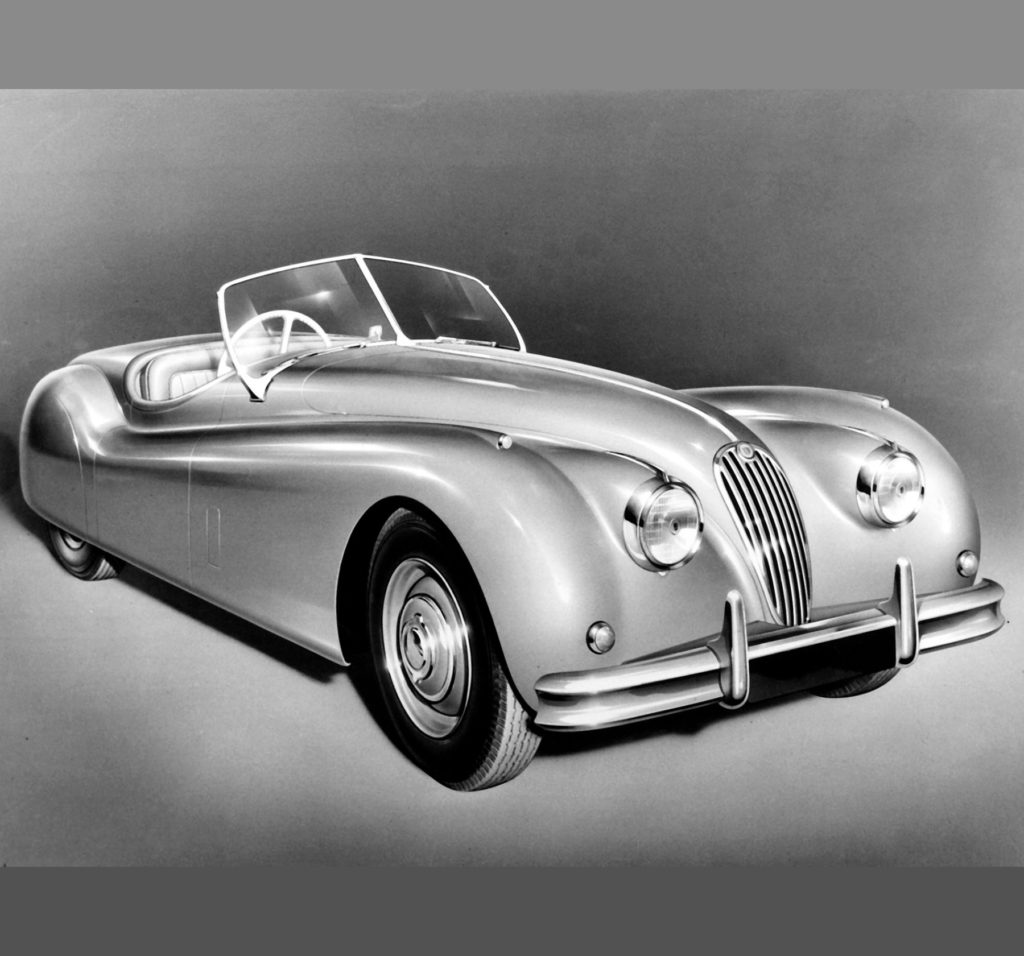
Denise McCluggage
“Once on a dark lonely backstretch at Sebring I had my own petite epiphany, the slower your breath the faster you go”.
Denise McCluggage who died in 2018, aged 88 was an American racing driver, journalist, author, photographer and pioneer of equality for women. Born in Kansas, she graduated Phi Beta Kappa in Philosophy and, pursuing a career in journalism, moved to San Francisco to write for the “Chronicle”.
Aged 22, she bought a black MG-TC from Kjell Qvale the eminent American importer. At 24, she moved East to work for, The New York Herald Tribune. Starting out in the women’s feature section, a piece she had written on skiing from a woman’s perspective got her a place on the sport section.
In 1955 Denise bought a red Jaguar XK140 MC convertible which she lightened before racing by removing the back seats. She took first place in a five lap women’s race at The Sports Car Club of America National Tournament. A great friend of Stirling Moss, Denise would go on to drive Porches, Ferraris, Maseratis, and race at Sebring and Nürburgring also fighting against women’s exclusion from Le Mans.
She wrote a monthly column for Auto Week and in 2001 she became the only journalist to be inducted into the Automotive Hall of Fame. In 2012 she was also added to the Sebring Hall of Fame.
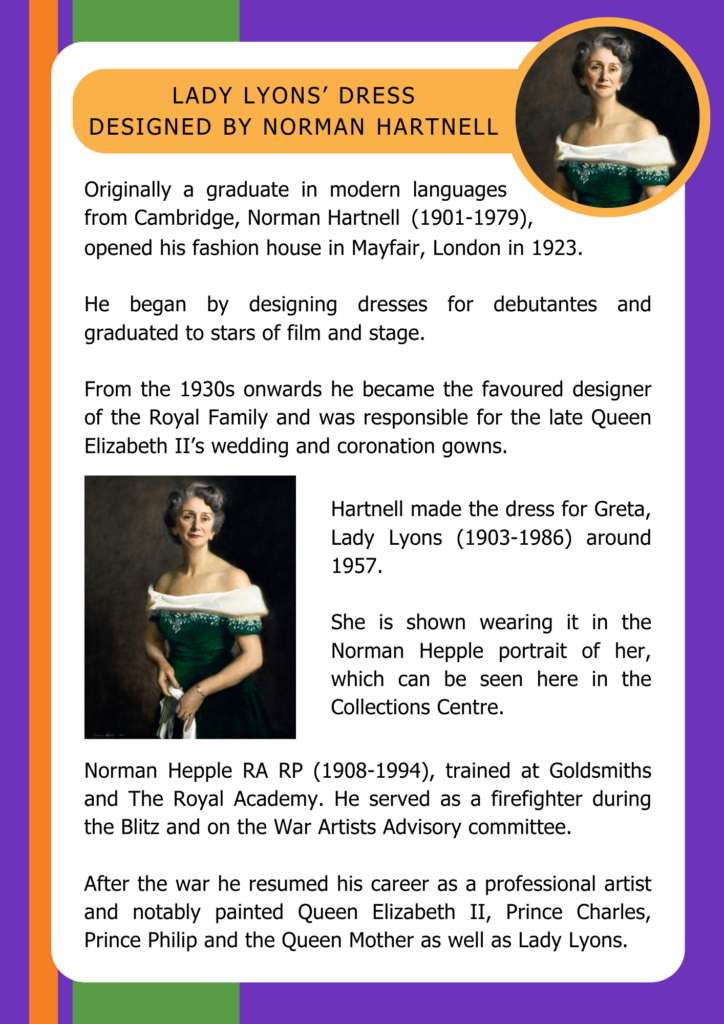
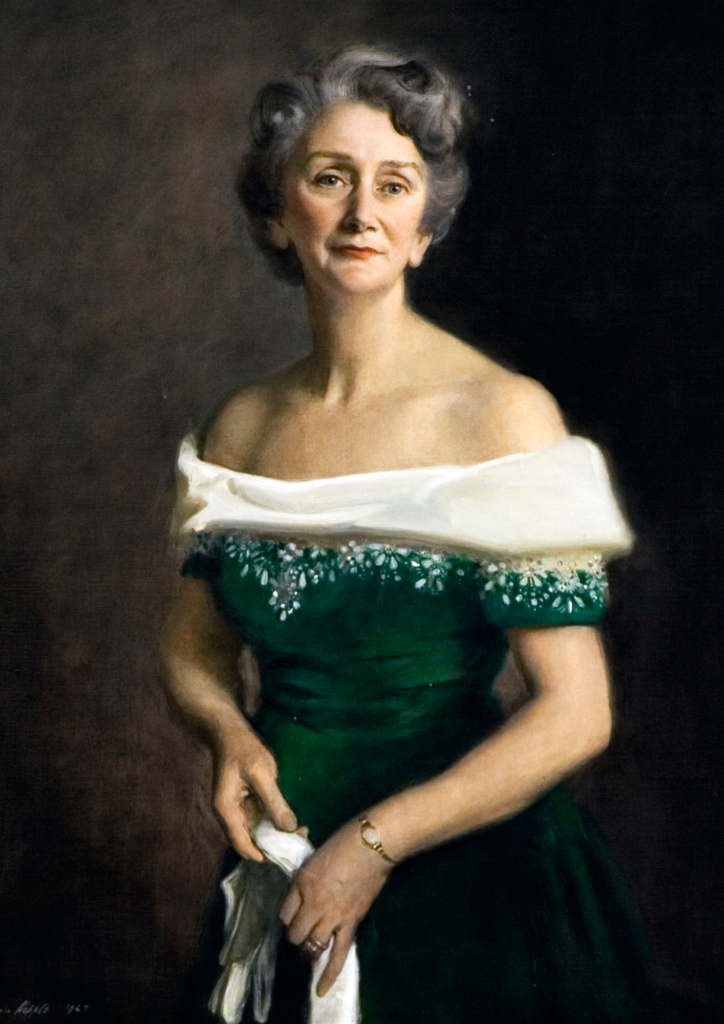
Lady Lyons’ Dress Designed by Norman Hartnell
Originally a graduate in modern languages from Cambridge, Norman Hartnell (1901-1979), opened his fashion house in Mayfair, London in 1923.
He began by designing dresses for debutantes and graduated to stars of film and stage.
From the 1930s onwards he became the favoured designer of the Royal Family and was responsible for the late Queen Elizabeth II’s wedding and coronation gowns.
Hartnell made the dress for Greta, Lady Lyons (1903-1986) around 1957.
She is shown wearing it in the Norman Hepple portrait of her, which can be seen here in the Collections Centre.
Norman Hepple RA RP (1908-1994), trained at Goldsmiths and The Royal Academy. He served as a firefighter during the Blitz and on the War Artists Advisory committee.
After the war he resumed his career as a professional artist and notably painted Queen Elizabeth II, Prince Charles, Prince Philip and the Queen Mother as well as Lady Lyons.
Click the button to read more information on Lady Lyons:
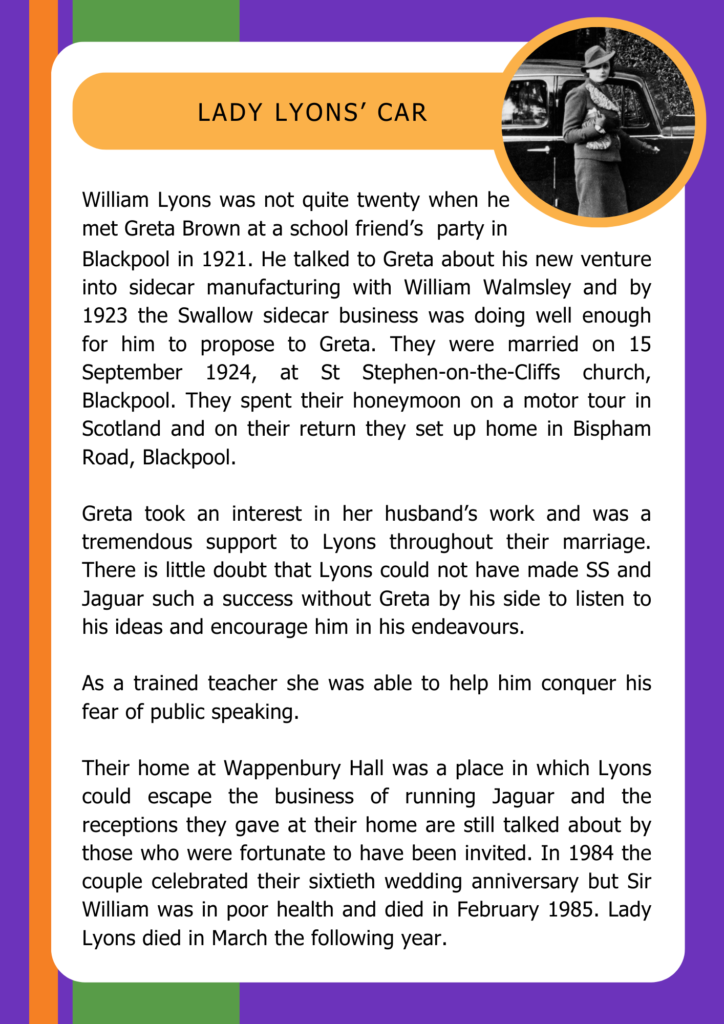
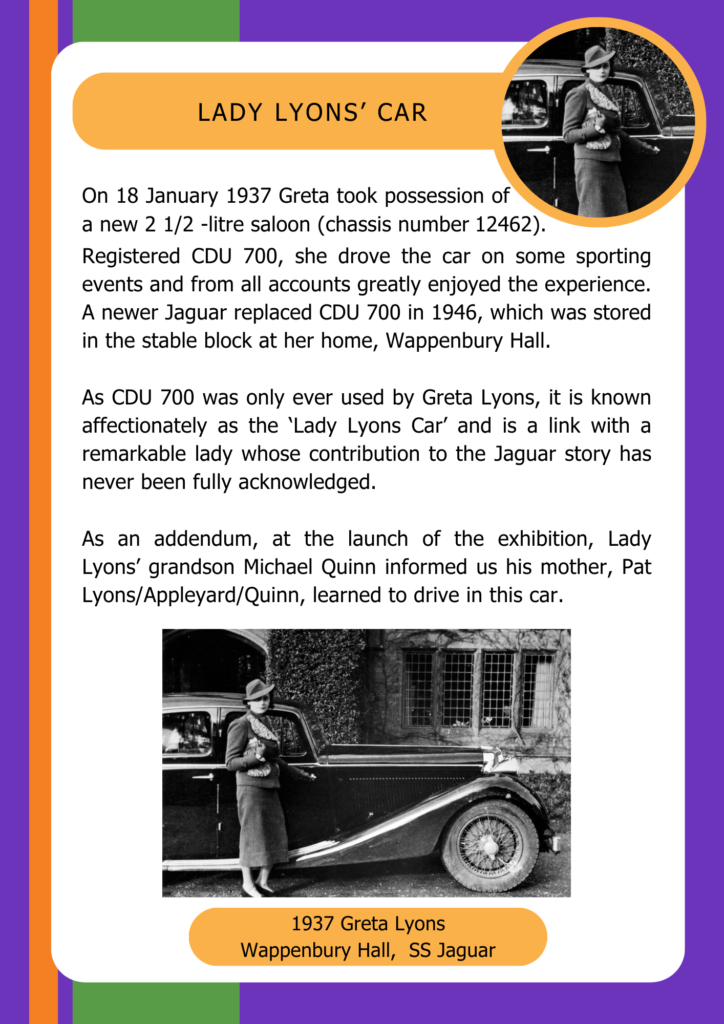
Lady Lyons’ Car
William Lyons was not quite twenty when he met Greta Brown at a school friend’s party in Blackpool in 1921. He talked to Greta about his new venture into sidecar manufacturing with William Walmsley and by 1923 the Swallow sidecar business was doing well enough for him to propose to Greta. They were married on 15 September 1924, at St Stephen-on-the-Cliffs church, Blackpool. They spent their honeymoon on a motor tour in Scotland and on their return they set up home in Bispham Road, Blackpool.
Greta took an interest in her husband’s work and was a tremendous support to Lyons throughout their marriage. There is little doubt that Lyons could not have made SS and Jaguar such a success without Greta by his side to listen to his ideas and encourage him in his endeavours.
As a trained teacher she was able to help him conquer his fear of public speaking.
Their home at Wappenbury Hall was a place in which Lyons could escape the business of running Jaguar and the receptions they gave at their home are still talked about by those who were fortunate to have been invited. In 1984 the couple celebrated their sixtieth wedding anniversary but Sir William was in poor health and died in February 1985. Lady Lyons died in March the following year.
On 18 January 1937 Greta took possession of a new 2 1/2 -litre saloon (chassis number 12462). Registered CDU 700, she drove the car on some sporting events and from all accounts greatly enjoyed the experience. A newer Jaguar replaced CDU 700 in 1946, which was stored in the stable block at her home, Wappenbury Hall.
As CDU 700 was only ever used by Greta Lyons, it is known affectionately as the ‘Lady Lyons Car’ and is a link with a remarkable lady whose contribution to the Jaguar story has never been fully acknowledged.
As an addendum, at the launch of the exhibition, Lady Lyons’ grandson Michael Quinn informed us his mother, Pat Lyons/Appleyard/Quinn, learned to drive in this car.
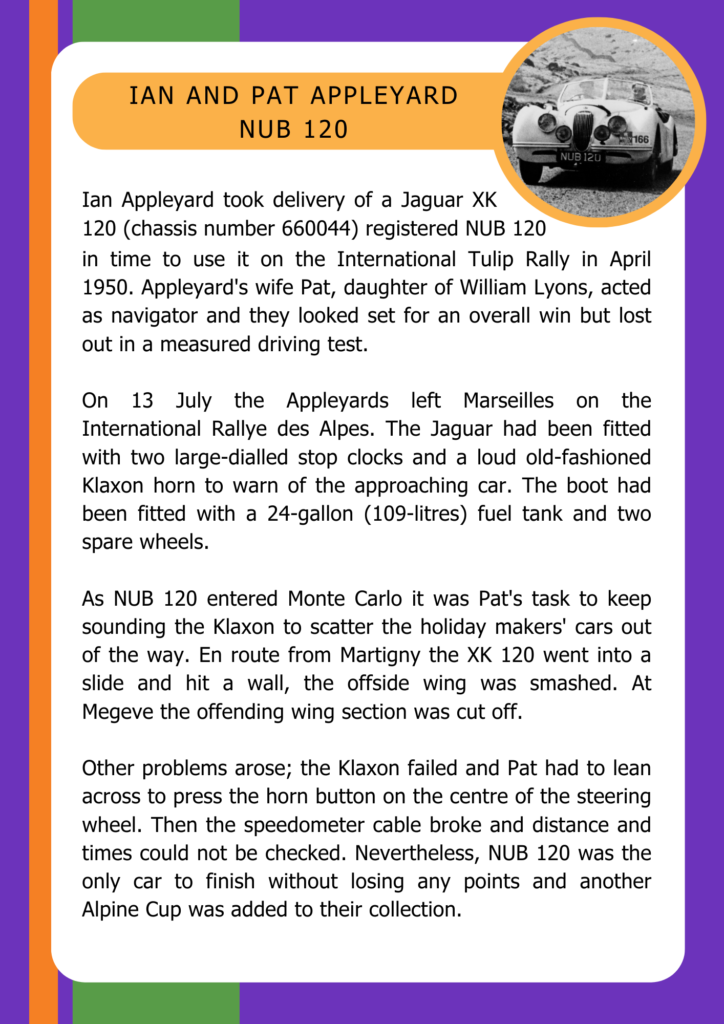
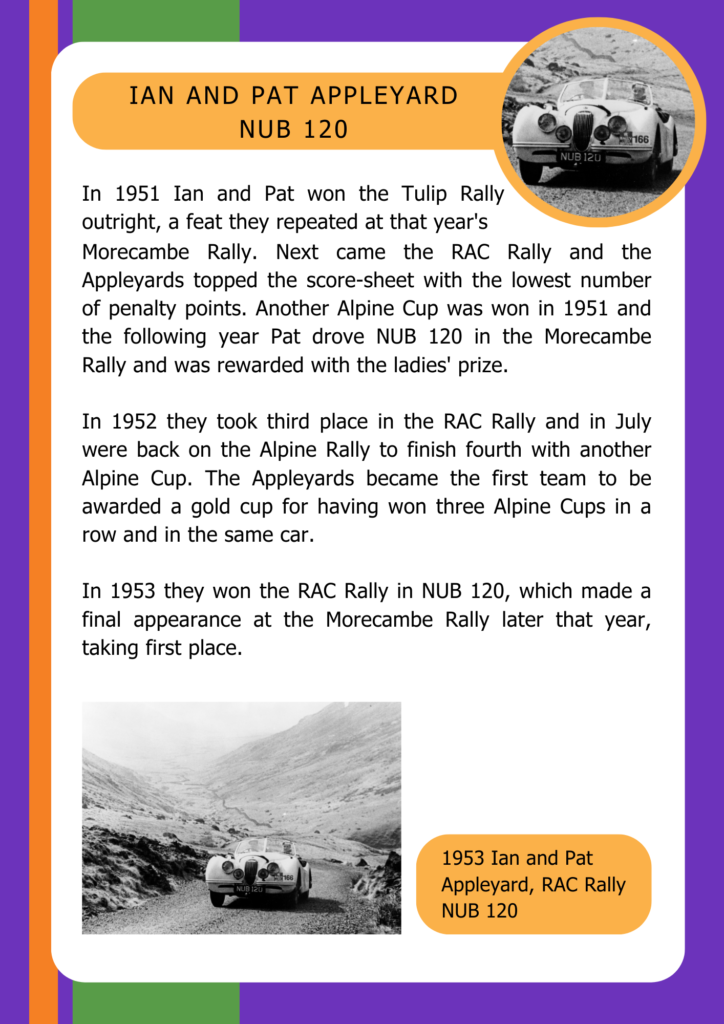
Ian and Pat Appleyard NUB 120
Ian Appleyard took delivery of Jaguar XK 120 (chassis number 660044) registered NUB 120 in time to use it on the International Tulip Rally in April 1950. Appleyard’s wife Pat, daughter of William Lyons, acted as navigator and they looked set for an overall win but lost out in a measured driving test.
On 13 July the Appleyards left Marseilles on the International Rallye des Alpes. The Jaguar had been fitted with two large-dialled stop clocks and a loud old-fashioned Klaxon horn to warn of the approaching car. The boot had been fitted with a 24-gallon (109-litres) fuel tank and two spare wheels.
As NUB 120 entered Monte Carlo it was Pat’s task to keep sounding the Klaxon to scatter the holiday makers’ cars out of the way. En route from Martigny the XK 120 went into a slide and hit a wall, the offside wing was smashed. At Megeve the offending wing section was cut off.
Other problems arose; the Klaxon failed and Pat had to lean across to press the horn button on the centre of the steering wheel. Then the speedometer cable broke and distance and times could not be checked. Nevertheless, NUB 120 was the only car to finish without losing any points and another Alpine Cup was added to their collection.
In 1951 Ian and Pat won the Tulip Rally outright, a feat they repeated at that year’s Morecambe Rally. Next came the RAC Rally and the Appleyards topped the score-sheet with the lowest number of penalty points. Another Alpine Cup was won in 1951 and the following year Pat drove NUB 120 in the Morecambe Rally and was rewarded with the ladies’ prize.
In 1952 they took third place in the RAC Rally and in July were back on the Alpine Rally to finish fourth with another Alpine Cup. The Appleyards became the first team to be awarded a gold cup for having won three Alpine Cups in a row and in the same car.
In 1953 they won the RAC Rally in NUB 120, which made a final appearance at the Morecambe Rally later that year, taking first place.
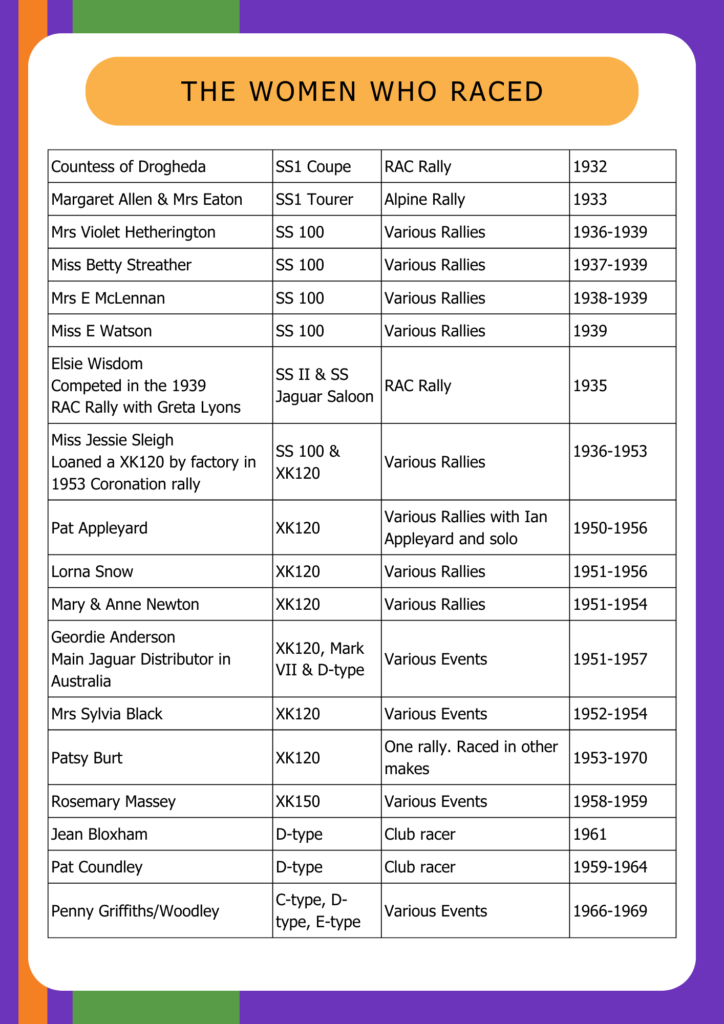
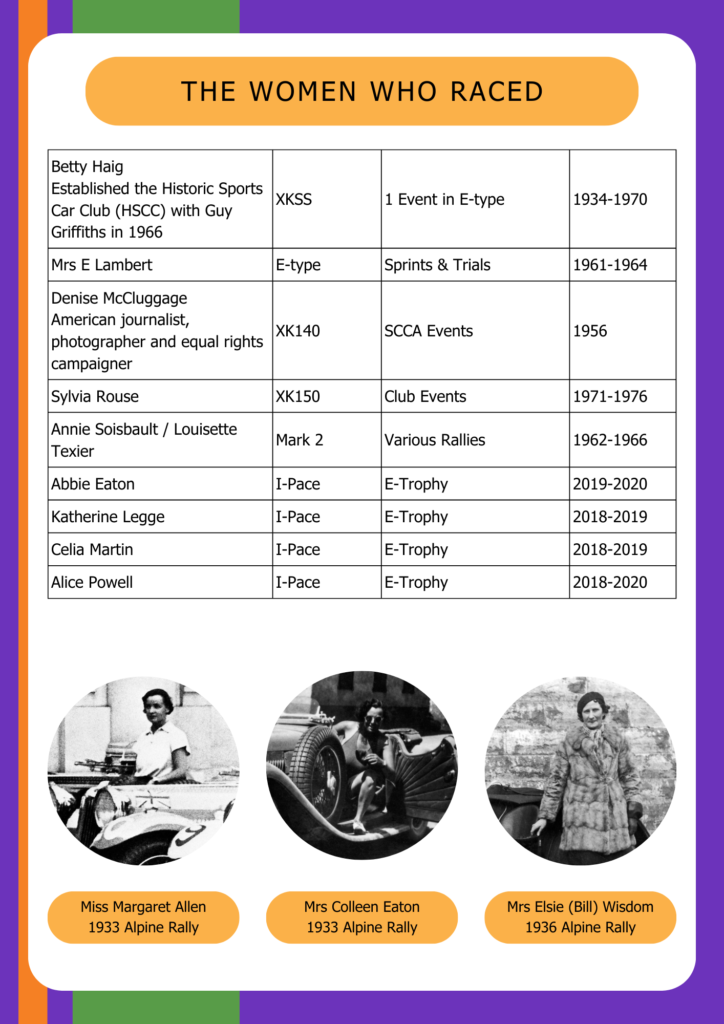
Document Cabinet
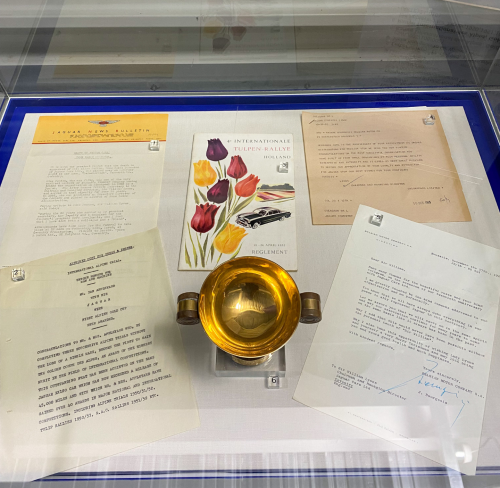
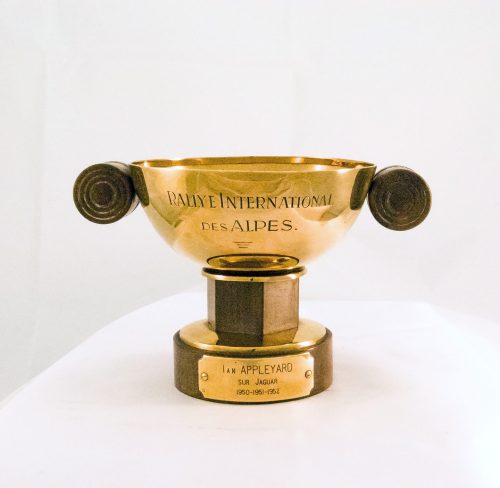
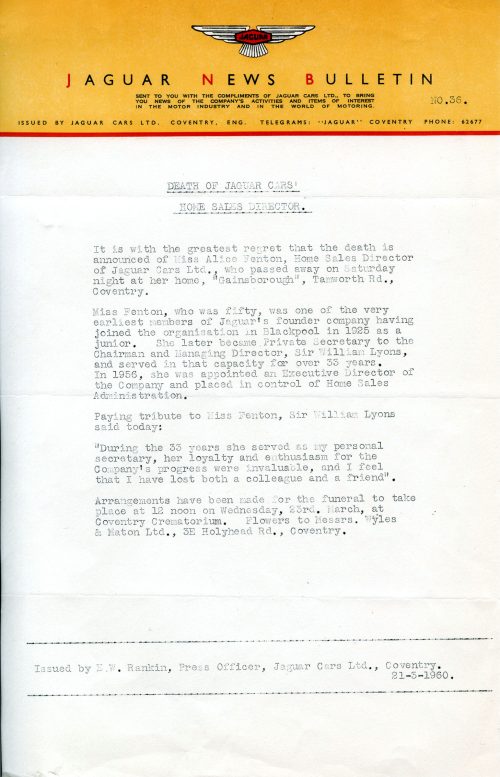
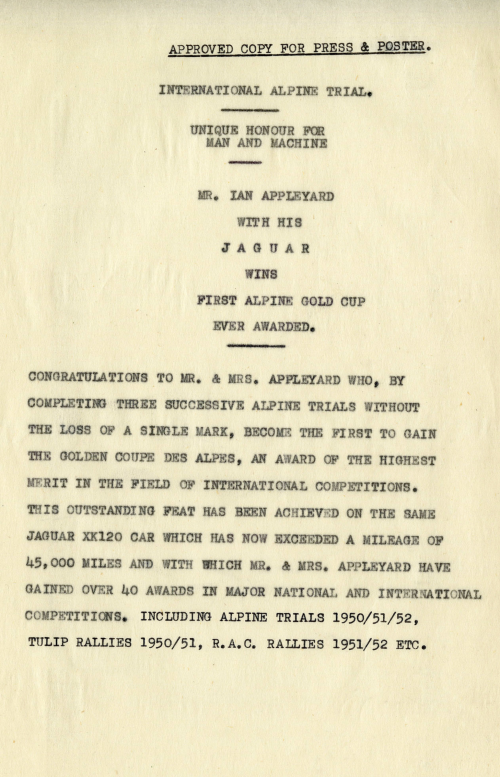
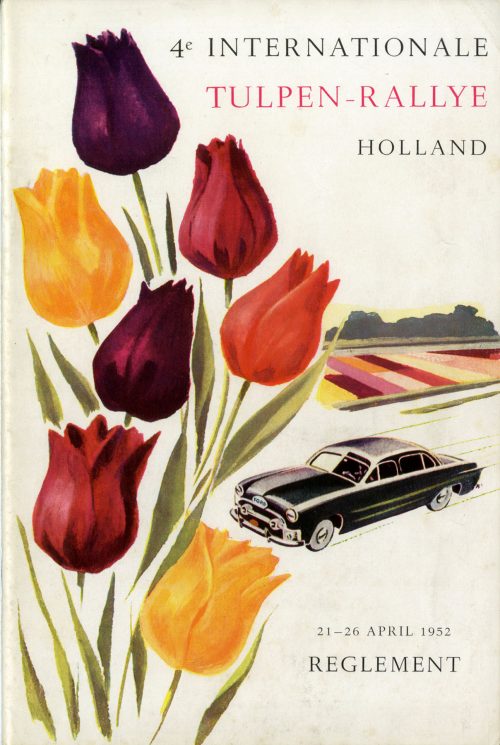
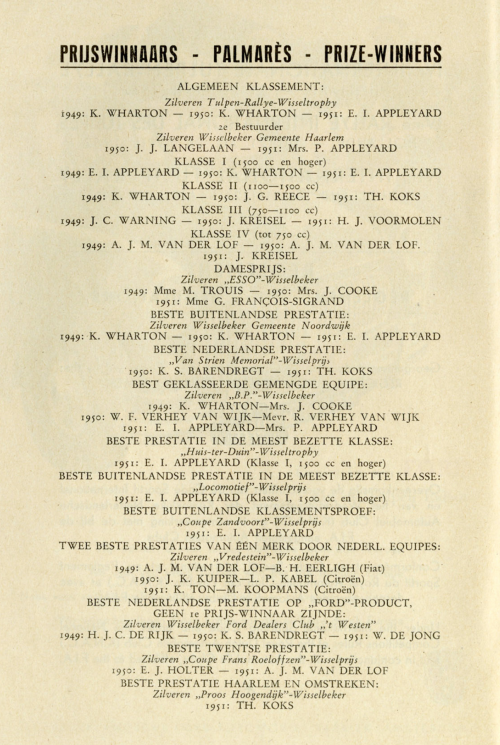
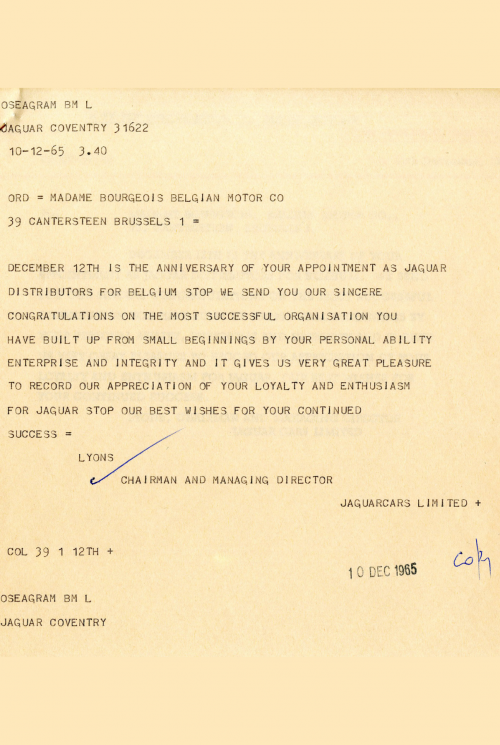
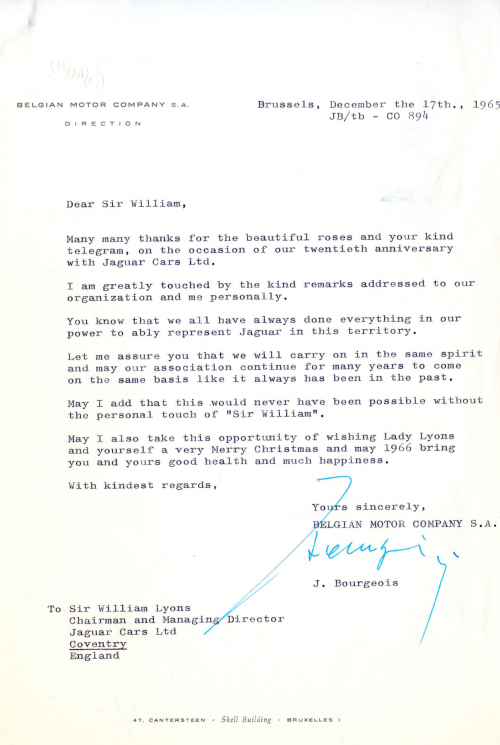
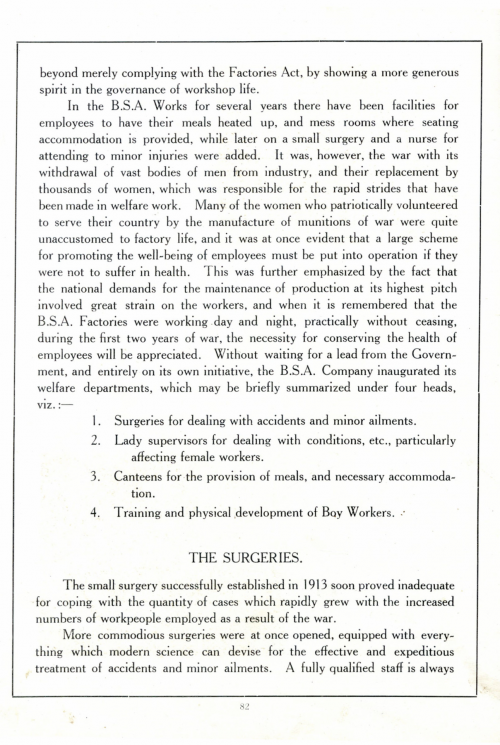
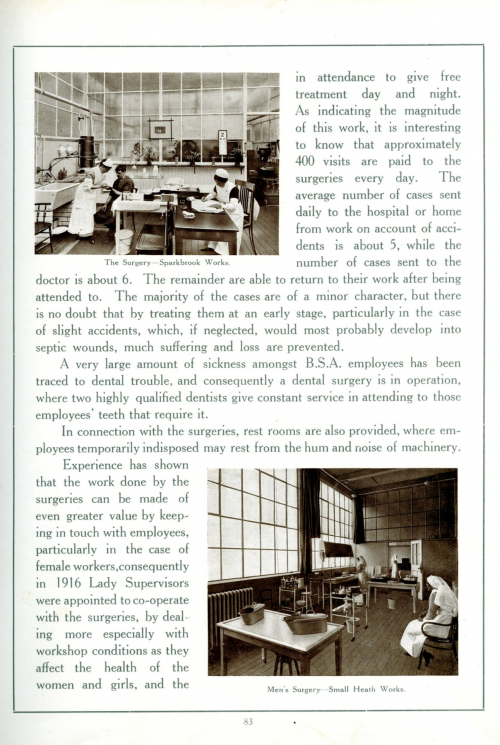
Archive Film
This film is a montage from our archive, featuring historical footage of women who drove, made, and sold Jaguars:
Group Discussion Film
This film was made by current and past employees of Jaguar Cars Ltd., Jaguar Land Rover (JLR), JLR Classic, and The Jaguar Daimler Heritage Trust (JDHT).
Their discussion explores women’s perceptions of the automotive industry, complemented by insights from current research, and shared experiences within the field:
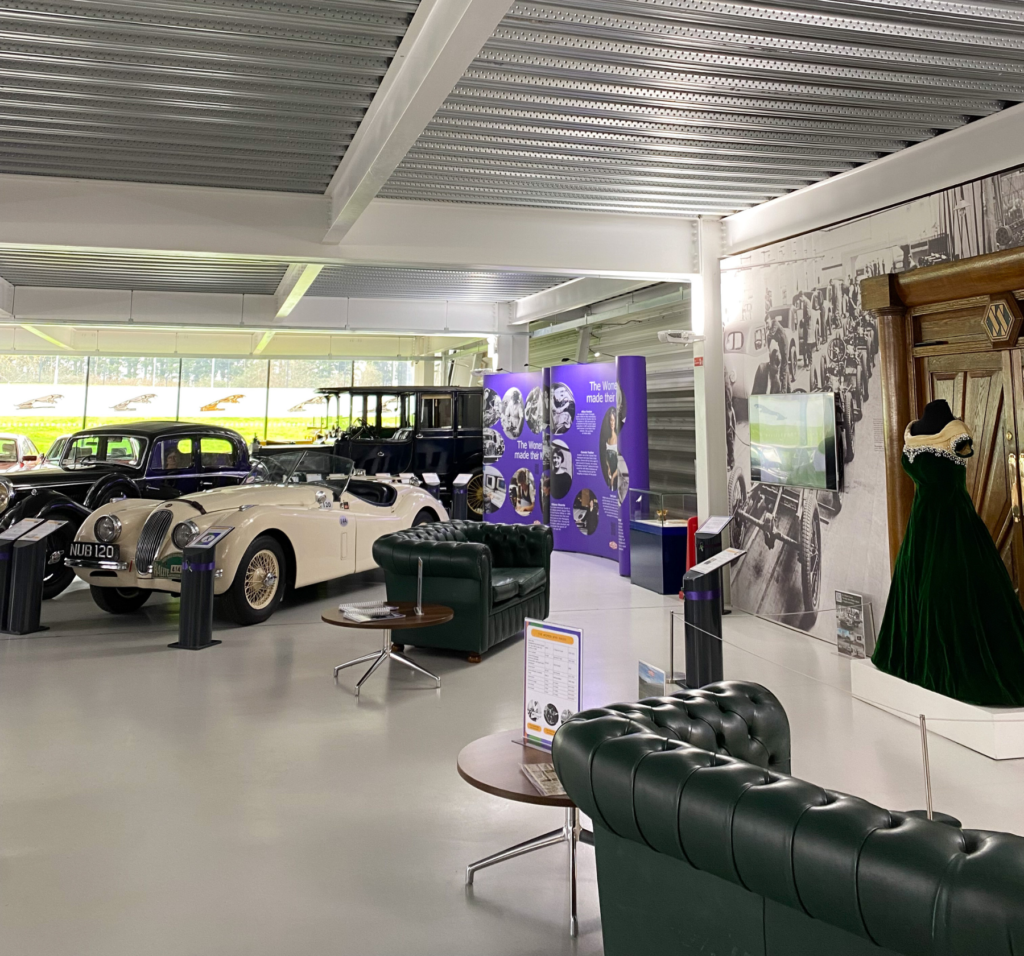
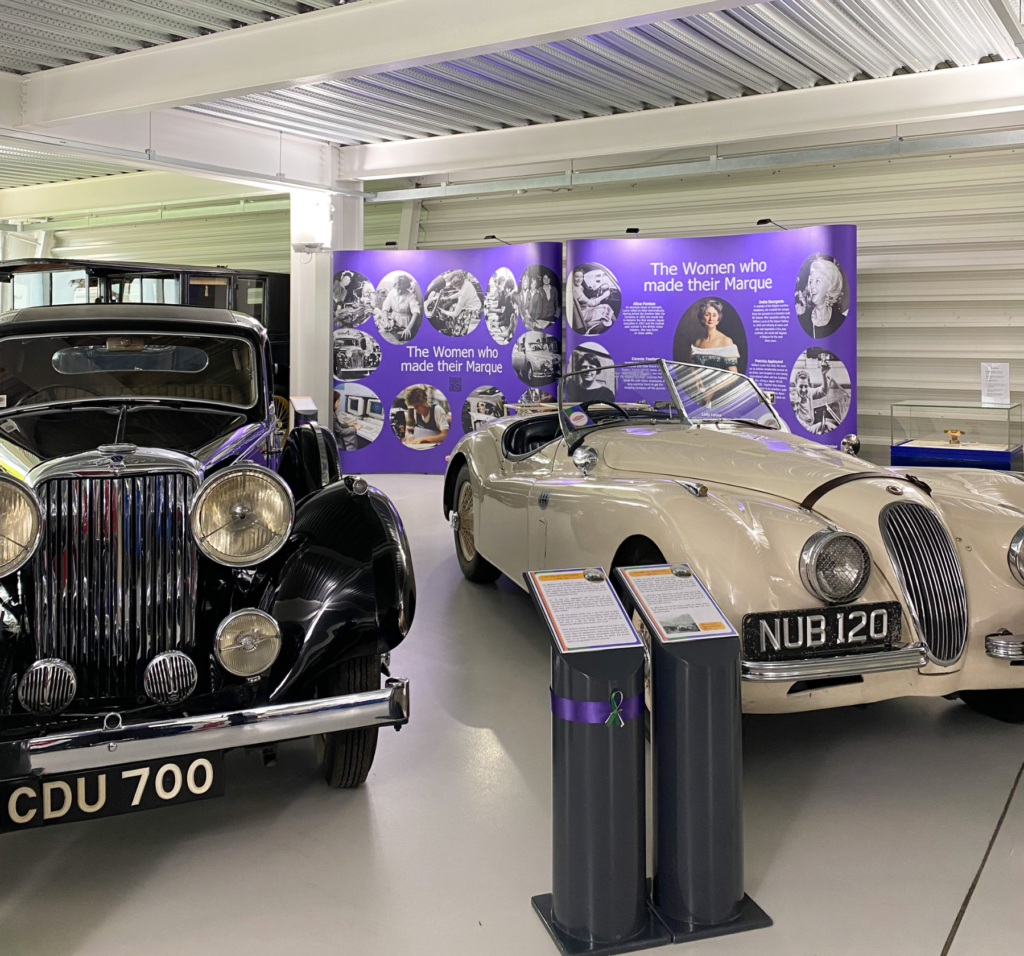
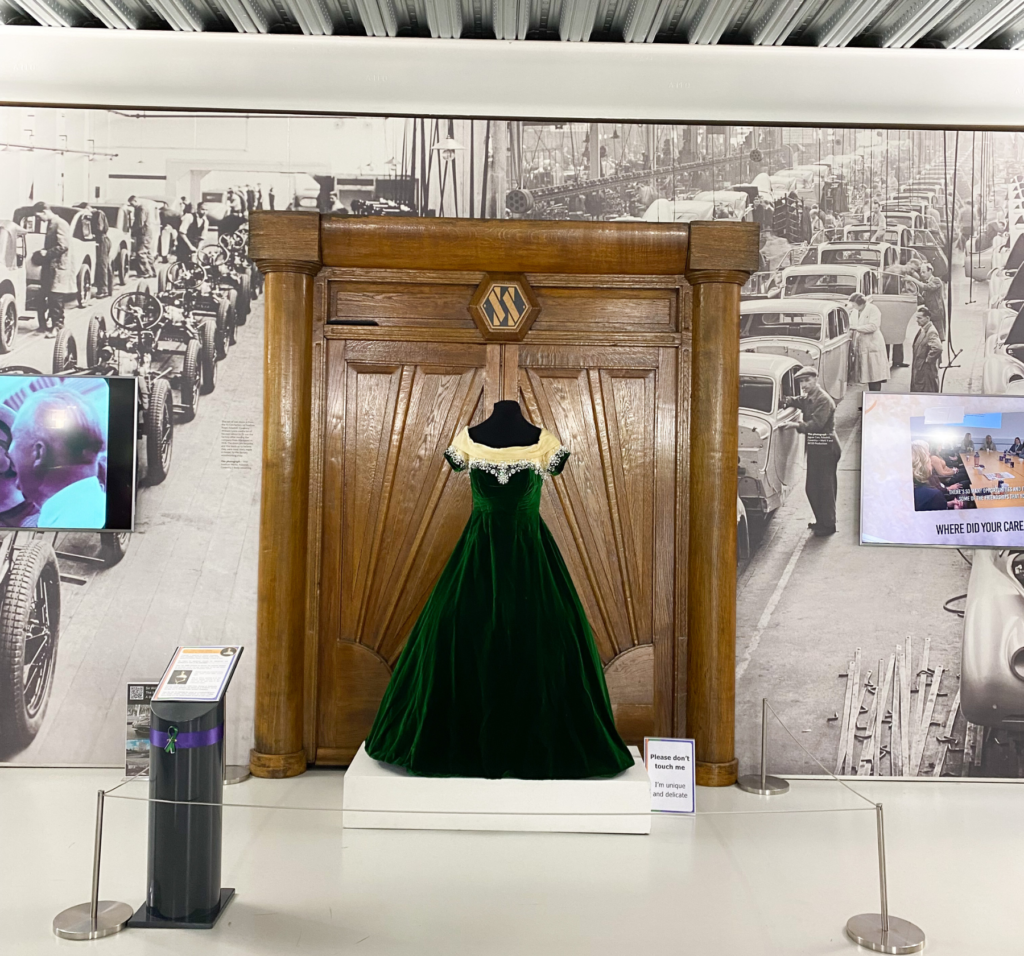
“The Women Who Made Their Marque” exhibition is now off display.